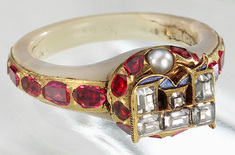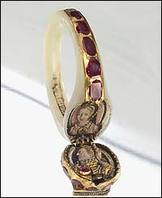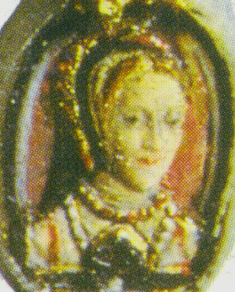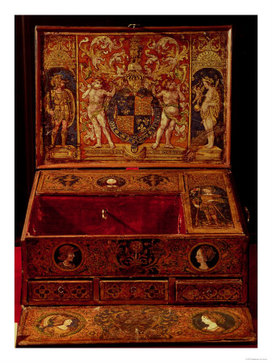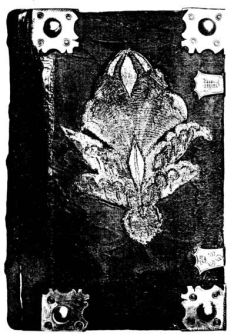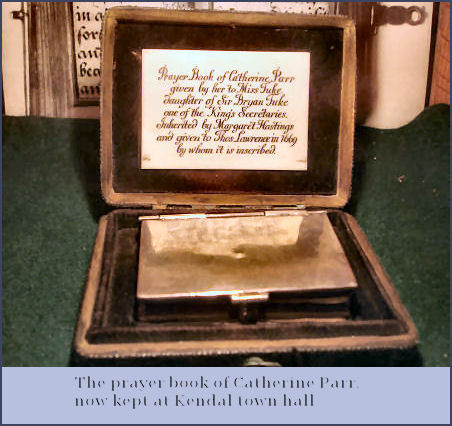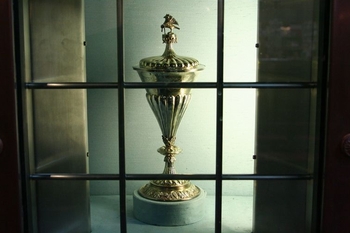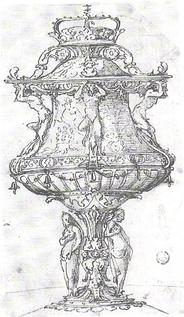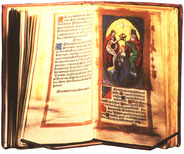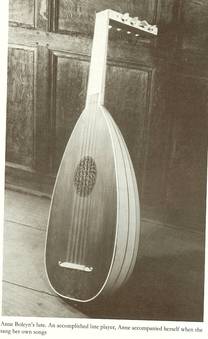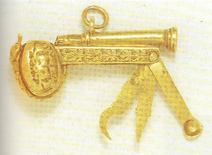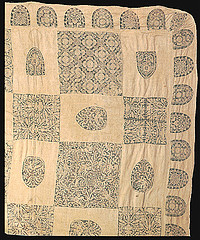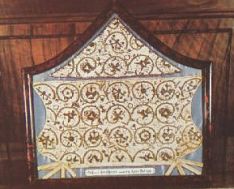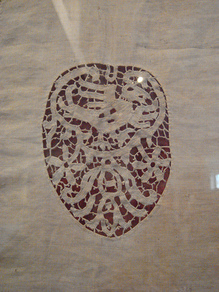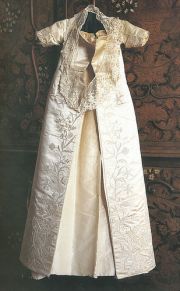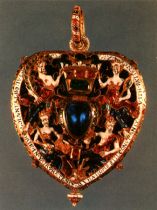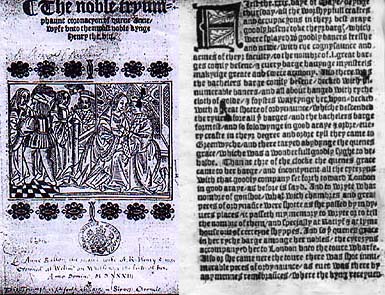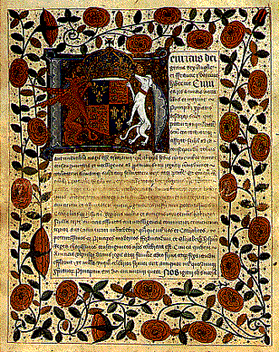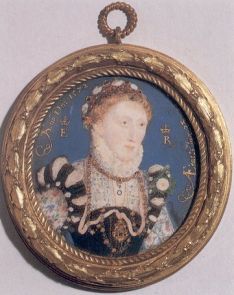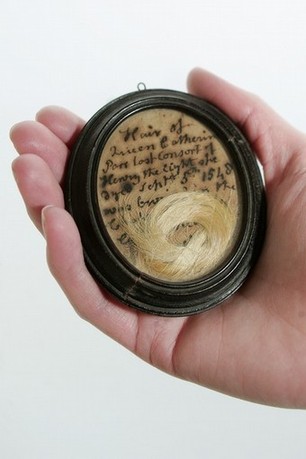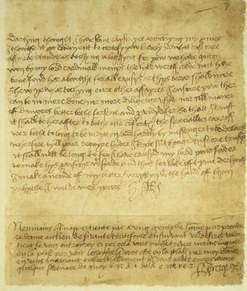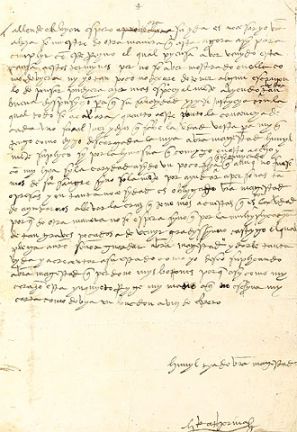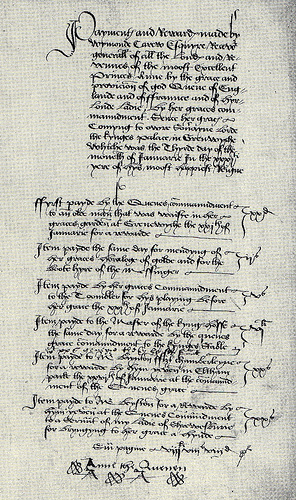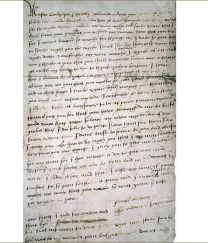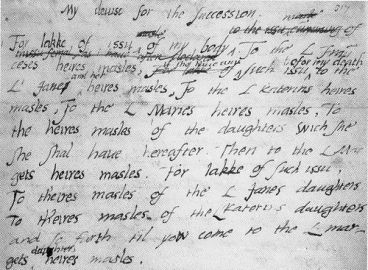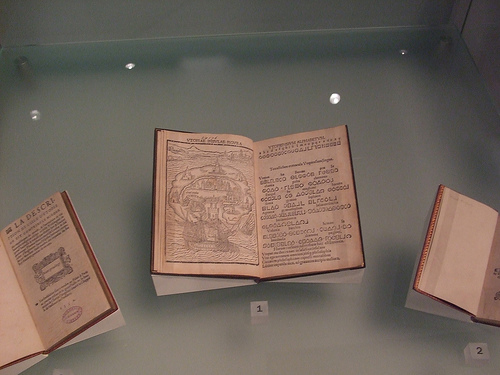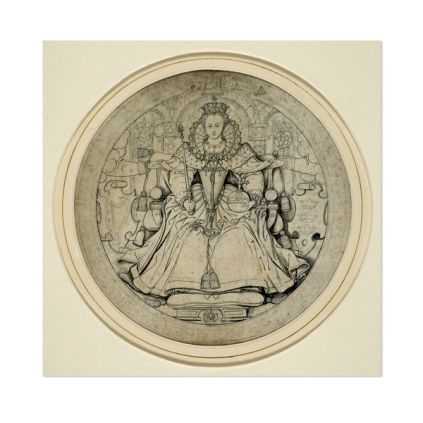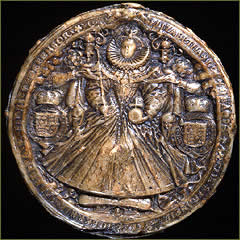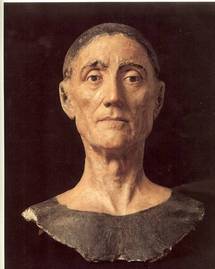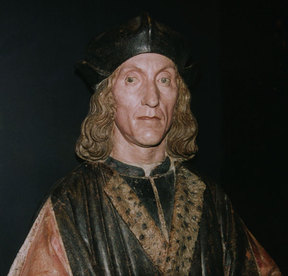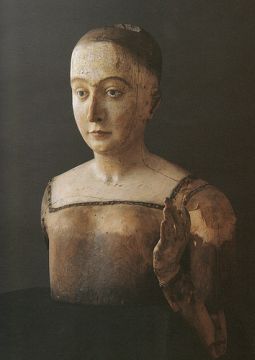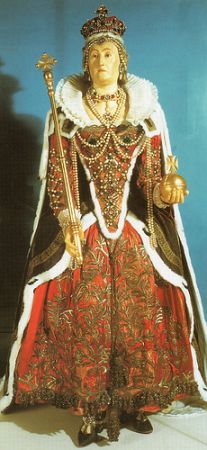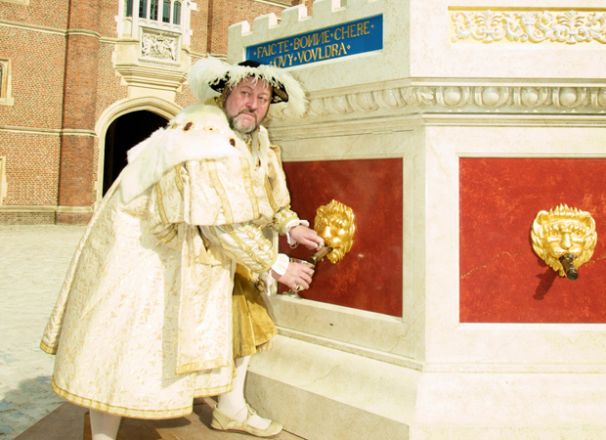Difference between revisions of "ARTIFACTS of the Tudors"
Jump to navigation
Jump to search
Small pics
Larger pics
LETTERS & HANDWRITING:
Effigies
(Created page with "<div class="WPC-editableContent"><table align="bottom" cellpadding="3" class="WPC-edit-border-all" width="750"> <tr> <td bgcolor="#1c1a1a" class="WPC-edit-custom-bgColor" wid...") |
|||
| Line 1: | Line 1: | ||
| − | <div class="WPC-editableContent"><table align="bottom" cellpadding="3" class="WPC-edit-border-all" width="750"> <tr> <td bgcolor="#1c1a1a" class="WPC-edit-custom-bgColor" width="100%"> <div align="center"> <font color="#ffa500" face="Garamond" size="6"><b><i>[[The Tudors Wiki]]</i></b></font></div> <div align="center"> <font color="#ffffff"><font size="4"><font color="#ffa500"> </font></font></font><h3 align="center"><font color="#ffffff"><font size="4"><font color="#ffa500"> <font size="6"><font size="-0"><font size="-0"><font size="-0"><font size="-0"><font size="-0"><b><font size="-0"><font size="-0"><font size="-0"><font size="-0"><font color="#ffffff"><font face="harrington"><b><font color="#ffa500" size="7">Virtual Museum of Tudor Possessions<br/></font></b></font></font></font></font></font></font></b></font></font></font></font></font></font></font></font></font></h3> <div align="center"> <font color="#ffffff" size="2"><b>Want to add to <i>The Tudors</i> museum page?</b></font><br/><b><font size="2">It must be an actual artifact - not just a text about one.</font></b></div> <div align="center"> <font color="#ffffff"><font size="3"><font size="2">Click EasyEdit to update this page!</font> </font></font></div> <div align="center"> <font color="#ffffff" size="2">(Don't see the <i>EasyEdit </i>button above? </font></div> <div align="center"> <font color="#ffffff" size="2"><a href="/#signin" target="_self"><font color="#90d6d6">Sign in</font></a> or <a href="/accountnew" target="_self"><font color="#90d6d6">Sign up</font></a></font><font color="#ffffff" size="2">.)</font></div></div></td></tr></table> <div align="center"> </div> <div align="center"> </div> <table align="bottom" cellpadding="6" class="WPC-edit-border-all" width="750"> <tr> <td width="50%"> <div align="center"> [[File:YbSvakw1N3DbJBrOHdoI-g34200.jpeg|235px|Anne Boleyn - The Tudors Wiki]]</div><br/><div align="center"> [[File:-P T7Ug8WzVNCDbYtbeqxA5863.jpeg|162px|Anne Boleyn - The Tudors Wiki]]</div> <div align="center"> <font size="3"><b>Above is the locket ring which belonged</b><br/></font><font size="3"><b>to Queen [[Elizabeth I]]. </b><br/></font><font size="3"><b>The ring bears the initial 'E' in table-cut </b><br/></font><font size="3"><b>diamonds and contains two </b></font><font size="3"><b>miniature busts -- one of </b></font><font size="3"><b><font color="#90d6d6">[[Anne Boleyn]]</font> (see close-up to the right) and one of Elizabeth herself.</b></font></div></td> <td width="50%"> <div align="center"> <font size="2"><br/></font><br/><i>[[File:AwEFWBuBpBY1t1Gy15M3XA13490.jpeg|282px|Anne Boleyn - The Tudors Wiki]]</i></div> <div align="center"> <font size="2">[[File:DvoFkgoRTFiWcMclhIxzpQ112678.jpeg|235px|Anne Boleyn - The Tudors Wiki|link=Queen Elizabeth I - Page 2]]</font></div> <div align="center"> <font size="2">Miniature portrait of <b><font color="#90d6d6">[[Anne Boleyn]]</font> -</b></font><br/><b><font size="2">inside the ring that her daughter [[Elizabeth I]] </font></b><br/><b><font size="2">constantly </font></b><b><font size="2">wore and was removed from her finger </font></b><br/><b><font size="2">after her death and </font></b><b><font size="2">sent to James VI of Scotland </font></b><br/><b><font size="2">as evidence of her death, </font></b><b><font size="2">showing how important </font></b><br/><b><font size="2">the ring and her mother were to Elizabeth.</font></b></div></td></tr></table> <table align="bottom" cellpadding="3" class="WPC-edit-border-all" width="750"> <tr> <td width="100%"> <embed align="left" height="350" src="http://widget.wetpaintserv.us/wiki/thetudorswiki/page/The+Tudors+Artifacts/widget/youtubevideo/7e518def81e83edab147b3cdfd484c066f89e174" type="application/x-shockwave-flash" width="425" wmode="transparent"/><font size="3"><b><font face="Times" size="4"><br/>Queen Elizabeth I's locket ring</font> - </b>[source: littlemisssunnydale (youtube)]<br/><br/></font><font size="3">Short video on a ring, believed to have been owned by Elizabeth I, that contains an image of herself and [[Anne Boleyn]].<br/><br/>The ring appears to have passed into the possession of Elizabeth's successor, James I, who in turn gave it to the Home family. The ring is often referred to as the 'Chequers ring' because it belongs to the Trustees of Chequers. Chequers...<br/><br/></font><font size="2"><font size="3">Starts with a clip from "The Virgin Queen" starring Anne Marie Duff as Elizabeth I, showing her death.</font> </font></td></tr> <tr> <td bgcolor="#1c1a1a" class="WPC-edit-custom-bgColor" width="100%"><br/></td></tr> <tr> <td width="100%"> <font size="2">[[File:JJVx-PL3pJPv1yZ-tFrn1g22388.jpeg|226px|Henry's chain of office]]<b><font face="Times" size="4">The only known surviving chain of office from th</font><font face="Times" size="4">e time of Henry VIII </font>is being put up for auction.</b> The king gave the gold Coleridge Collar to one of his closest advisers, Sir Edward Montagu, around 1546. The chains showed allegiance to the monarch and the intricacy of the design and quality of the metal signified the status of the wearer. It is expected to fetch £300,000 when it goes under the hammer at Christie's in London on 6 November. It will be the first time that the Coleridge Collar, thought to be of the most important surviving relics of the Tudor age, has come up for auction. Sir Edward is thought to have received the collar on his appointment to the role of Lord Chief Justice of the Common Pleas - one of the highest judicial officials in England. This type of <b>livery collar</b>, as it was known, became popular when they were used by Henry IV as an official symbol of allegiance to the monarch. It was known as the "collar of the Esses", referring to the S characters used in the design alluding to the Latin religious creed Spiritus Sanctus - or holy spirit. The Tudors later added their own designs of roses and portcullises. <b><font color="#ffa500">Henry VIII is thought to have awarded only about 20 of the chains to loyal subjects for "special deeds" and none were believed to have survived in their entirety.</font> <br/><br/></b>But when the role of Lord Chief Justice of the Common Pleas was merged with another title in 1880 to create the Lord Chief Justice of England - the chain of office became superfluous. It then became the personal property of Lord Coleridge and passed through his family, changing ownership only once since the 19th Century. It was discovered in the Devon family home of poet Samuel Taylor Coleridge earlier this year. Experts say the collar is similar to the one worn by [[Sir Thomas More]] in the famous portrait by [[Hans Holbein]] the Younger. Andreas Pampoulides, Christie's London director and co-head of sale said: "The Coleridge Collar is an extraordinary and fascinating piece of history, both as a work of art, and also as a rare Tudor relic.<font size="3"><i> "An extremely rare example of early English goldsmith-work, the collar also represents the only known, complete, surviving collar of office from the time of Henry VIII, one of the most renowned of European monarchs." </i></font>The collar is part of Christie's Important European Furniture, Sculpture and Tapestries sale. <br/>[<i>Source : </i><a class="external" href="http://news.bbc.co.uk/1/hi/uk/7653348.stm" rel="nofollow" target="_blank" title="BBC news"><i>BBC news</i></a> <i>October 5, 2008]</i></font> </td></tr> <tr> <td width="100%"> <br/><div align="center"> <font face="Times" size="5"><a class="external" href="http://www.youtube.com/watch?v=bpkk_zNTU2c" rel="nofollow" target="_blank" title="A Video featuring Henry's prayer roll">A Video featuring Henry's prayer roll</a></font></div></td></tr></table><br/><table align="bottom" cellpadding="3" class="WPC-edit-style-grid1 WPC-edit-border-all WPC-edit-styleData-color1=%23191919&color2=%23474747" width="750"> <tr> <td class="" width="100%"> <br/><div align="center"> <embed allowfullscreen="true" flashvars="config_settings_showUpdatedInFooter=true&config_settings_showPopoutButton=false&playlist=http%3A%2F%2Fnews%2Ebbc%2Eco%2Euk%2Fmedia%2Femp%2F8110000%2F8116000%2F8116029%2Exml&config=http%3A%2F%2Fnews%2Ebbc%2Eco%2Euk%2Fplayer%2Femp%2Fconfig%2Fdefault%2Exml%3F2%2E18%2E13034%5F13155%5F20091009165324&config_settings_language=default&config_settings_showFooter=true&config_plugin_fmtjLiveStats_pageType=eav6&config_settings_showPopoutButton=false&config_settings_showPopoutCta=false&config_settings_addReferrerToPlaylistRequest=true" height="400" src="http://widget.wetpaintserv.us/wiki/thetudorswiki/widget/unknown/552e41d0d3a3ee1392f068f33ffb2f266a6e307e" type="application/x-shockwave-flash" width="512" wmode="transparent"/><br/><font size="4"><b>Replica of letter on Henry VIII divorce unveiled</b></font> VATICAN CITY — <br/><font size="2">Officials unveiled a replica of a 1530 parchment sent by members of England’s <br/>House of Lords to [[Pope Clement VII]] to support the divorce of [[King Henry VIII]].<br/><br/>The 3-foot-by-6.5 foot (1-meter-by-2-meter) parchment with more than 80 original red wax seals<br/>of the signatories is considered a crucial document in the king’s battle to divorce his first wife, <br/>Catherine of Aragon. At the time, Henry VIII was obsessed with producing a male heir to the throne.<br/>The Vatican’s refusal to annul the marriage led the king to reject the authority of the pope and <br/>install himself as head of the Church of England. <br/>He then married [[Anne Boleyn]].</font><br/><i><br/></i><div align="left"> </div><font size="2"><i>“It is an event of enormous magnitude, the most important event in English history,</i>”<b> David Starkey</b>, a British historian <br/>and Tudor family expert, said in an interview with Associated Press Television News.<br/><i>“This is the moment at which England ceases to be a normal European Catholic country and goes off <br/>on this strange path that leads it to the Atlantic, to the new world, to Protestantism, to Euro-skepticism.” </i></font><br/><br/><div align="left"> </div><font size="2">In the letter, written in Latin, the lords urge the pope to annul the marriage to help give the kingdom an heir and prevent a bloody fight between successors.Henry <i>“will surely guarantee stability to the kingdom if he will be able to entrust its government to a male heir,” </i>the letter says, according to translated excerpts provided by the Scrinium publishing house.The noblemen also foreshadow the coming schism by threatening that should the pope <i>“neglect the needs of the English, they would feel authorized to solve the issue on their own and find remedies elsewhere."</i> </font><div align="left"> </div><font size="2">Officials said that while the original document will remain in the Vatican Secret Archives, they plan to put the copy on display. </font></div></td></tr></table><br/><table align="bottom" cellpadding="3" class="WPC-edit-border-all" width="750"> <tr> <td align="center" width="50%"> <br/><br/><br/>[[File:WSEPaG2rXKCwXlBSuyFnqw93085.jpeg|356px|Embroidery by Katherine of Aragon]][[Queen Katherine of Aragon]]'s <br/>emblem of the pomegranate. <br/>From an altar cloth <i>made by</i> Katherine<br/>that is currently housed in St Peter’s Church<br/>in Winchcombe, Gloucestershire.</td> <td align="center" width="50%"> <div align="center"> [[File:D1ErAWEWfI6IpHjDBEiTzw40129.jpeg|272px|Queen Katherine of Aragon - Page 2 - The Tudors Wiki]]</div> <div align="center"> <font size="2">Royal Desk with King Henry<br/>& [[Queen Katherine of Aragon]]'s arms<br/><br/>Link: <a class="external" href="http://www.vam.ac.uk/collections/furniture/videos/royal_desk/broadband.html" rel="nofollow" target="_blank" title="Video of the royal desk at the V&A">Video of the royal desk at the V&A</a><br/><br/><br/></font></div></td></tr> <tr> <td align="center" class="WPC-edit-borderRight-solid2px" width="50%"> [[File:59ofZTmxK0NVbMv2lAbBzQ61065.jpeg|326px|Catherine Parr's book of prayers]]<font size="2"><i><br/>Prayers or Meditations</i> by Queen [[Catherine Parr]]. Translated into Latin, French, and Italian by the [Lady] [[Princess Elizabeth Tudor]]. 1545.</font><font size="2"><br/></font><font size="2"><i>ENGLISH EMBROIDERED BOOKBINDINGS</i></font><br/><font size="2">CHAPTER II - Book Bound in Canvas<br/>BY CYRIL DAVENPORT, F.S.A<br/></font></td> <td class="WPC-edit-borderTop-solid2px WPC-edit-borderLeft-solid2px WPC-edit-borderRight-solid2px WPC-edit-borderBottom-solid2px" width="50%"><div align="center"> </div><div align="center"> <font size="2">Another manuscript beautifully written by the Princess Elizabeth Tudor is now at the British Museum. It is on vellum, and contains prayers or meditations, composed originally by Queen [[Catherine Parr]] in English, and translated by the Lady Elizabeth into Latin, French, and Italian. The title as given in the book reads, 'Precationes ... ex piis scriptoribus per nobiliss. et pientiss. D. Catharinam Anglie, Francie, Hibernieq. reginam collecte, et per D. Elizabetam ex anglico converse.' It is, moreover, dedicated to Henry VIII, the wording being, 'Illustrissimo Henrico octavo, Anglie, Francie, Hibernieq. regi,' etc., and dated Hertford, 20th December 1545.<br/><br/></font><font size="2">It is bound in canvas, and measures 5¾ by 4 inches, the groundwork being broadly worked in tapestry-stitch, or some stitch analogous to it, in red silk, resembling in method the work on the ground of <i>The Miroir of the Synneful Soul</i> described below. On this, in the centre of each side, is a large monogram worked in blue silk, interwoven with silver thread, containing the letters K, probably standing for Katherine, A, F, H, and R, possibly meaning 'Anglie, Francie, Hibernieque, Reginæ,' but like most monograms this one can doubtless be otherwise interpreted. <br/><br/>Above and below the monogram are smaller H's, worked in red silk, interwoven with gold thread. In each corner is a heartsease of yellow and purple silk, interwoven with gold thread, and having small green leaves between each of the petals. The work which was once on the back is now so worn that it cannot be traced sufficiently to tell what it originally was.</font></div></td></tr> <tr><td align="center" width="50%"><div align="center"> [[File:JEtmMt4IgPTy7it 6xKLvg46168.jpeg|234px|Queen Mary's psalter]]</div> <div align="center"> <font size="2">Psalter belonging to Mary I. <br/>The beautiful English manuscript of the fourteenth century known as 'Queen Mary's Psalter' was presented to her in 1553. It is bound in crimson velvet, measuring 11 by 6¾ inches, and appliqué on each side is a large conventional pomegranate-flower worked on fine linen in coloured silks and gold thread. This flower is much worn, but enough is left to show that it was originally finely worked. Queen Mary used the pomegranate as a badge in memory of her mother, Katharine of Aragon. The volume has been re-backed in plain crimson velvet, and still retains the original gilt corners with bosses, and two clasps, on the plates of which are engraved the Tudor emblems,—portcullis, dragon, lion, and fleur-de-lys. --</font><br/><font size="2"><i>ENGLISH EMBROIDERED BOOKBINDINGS</i><br/> Chapter III - Books Bound in Velvet<br/> BY CYRIL DAVENPORT, F. S. A </font></div></td><td align="center" width="50%">[[File:P-j6ygmuq-COBFOMCzq4 Q100023.jpeg|317px|The Tudors Artifacts - The Tudors Wiki]]<br/><div align="center"><font size="2">[[Hans Holbein]] the Younger (1497/8–1543)<br/><br/>Designs for Metalwork Covers and Caskets</font> <font size="2"> (about 1537) <br/>The two book covers feature clasps to close the book and a ring by which such small books were usually attached to a woman’s girdle (see the examples in the case nearby). Both books bear the initials ‘T’, ‘W’ and ‘I’, which probably stand for those of Sir [[Thomas Wyatt]] the Younger and his wife Jane Haute, who were married in 1537. </font><font size="2"><br/><br/>Source: Tate Gallery, London, Holbein exhibit online.<br/></font></div></td></tr><tr> <td align="center" width="50%"> <br/>[[File:0vFuF2RabqVPntuJG97dBg58037.jpeg|277px|Princess Elizabeth for her step-mother Katherine Parr, the embroidered front cover]]<br/>Elizabeth's embroidery of her translation of the French poem <i>The Mirror of the Sinfoul Soul</i>, 1544</td> <td width="50%"> <br/><div align="center"><font size="4">Left: <b>This Miroir or Glasse of the Synneful Soul</b></font> <br/><font size="2">[[Princess Elizabeth Tudor]] in her eleventh year, copied out in her own handwriting the Miroir or Glasse of the Synneful Soul. She says it is translated 'out of frenche ryme into english prose, joyning the sentences together as well as the capacitie of my symple witte and small lerning coulde extende themselves.' It is also most prettily dedicated: 'From Assherige, the last daye of the yeare of our Lord God 1544 ... To our most noble and vertuous Quene Katherin, Elizabeth her humble daughter wisheth perpetuall felicitie and everlasting joye.' <br/><br/>The design is the same upon both sides. The ground is all worked over in a large kind of tapestry-stitch in thick pale blue silk, very evenly and well done, so well that it has been considered more than once to be a piece of woven material. On this is a cleverly designed interlacing scroll-work of gold and silver braid, in the centre of which are the joined initials K. P.</font><font size="2"> [for Katherine Parr] The back is very much worn, but it probably had small flowers embroidered upon it.<br/><i>ENGLISH EMBROIDERED BOOKBINDING</i><br/>Chapter II - Books Bound in Canvas<br/>BY CYRIL DAVENPORT, F.S.A<br/></font></div></td></tr><tr><td align="center" width="50%"><br/><br/><br/>[[File:GoVnHViYo5El3lI8hj1Exw462027.png|330px|Katherine Parr copy of Vellutello edition of Petrarchra works (1544)]]<br/>Il Petrarcha. Venetia, 1544; [[Catherine Parr]].</td><td align="center" width="50%"><font size="2">Il Petrarcha. Venetia, 1544. Another fine example of the decorative use of Heraldry occurs on a copy of Petrarch printed at Venice in 1544, and probably bound about 1548, after the death of Henry VIII. It belonged to Queen [[Catherine Parr]], and bears her arms with several quarterings—worked appliqué on rich blue purple velvet, and measures 7 by 6 inches. The first coat is the 'coat of augmentation' granted to the Queen by Henry VIII —'Argent, on a pile gules, between six roses of the same, three others of the field'—and the next coat is that of 'Parr/Green.' [Catherine's parents impaled arms]</font><br/> <br/><div class="figcenter"> </div><font size="2">There are two supporters—that on the right, an animal breathing flame, and gorged with a coronet from which hangs a long chain, all worked in coloured silks on linen and appliqué, belongs to the Fitzhugh family, the coat of which is shown on the third quarter [Catherine's grandmother was Hon. Elizabeth FitzHugh]; that on the left, a wyvern argent, also gorged with a coronet, from which depends a long gold chain, is that of the Parr family. The wyvern is a piece of blue silk, finished in gold and silver cords, in appliqué. The gold cord enclosing the armorial design is amplified at each corner into an arabesque scroll. The book has been most unfortunately rebound, and the work is badly strained in consequence—the back being entirely new; nevertheless it is in a wonderful state of preservation. It is said to have been worked by Queen [[Catherine Parr]] herself. The design is too large for the book, and the crown is too large for the coat-of-arms. It is probable that the binding of the book was done after the death of Henry VIII, otherwise the supporters would have been the lion and the greyhound; also the coat-of-arms would have been different; also, as the Seymour coat does not appear, it is likely that the binding was done before the Queen Dowager [[Catherine Parr]]'s marriage with Lord Seymour of Sudley, in 1547. The design is the same on both sides.</font></td></tr><tr><td align="center" width="50%">[[File:CpLI lINbGTco8pxGpayUw39052.jpeg|307px|The Tudors Artifacts - The Tudors Wiki]]<br/><font size="2">The earliest extant English binding in embroidered velvet covers this manuscript, which belonged to Henry VIII, and is dedicated to him. The manuscript is on vellum, and is beautifully illuminated. It is bound in rich purple velvet, and each side, measuring 9 by 6 inches, is ornamented with the same design. In the centre is a large royal coat-of-arms, surrounded by the garter, and ensigned with a royal crown. On the coat are the arms of France and England quarterly; the bearings, respectively three fleur-de-lys and three lions, are solidly worked in gold cord, and the whole is appliqué on to the velvet with strong stitches. On the blue garter the legend 'Honi soit qui mal y pense' is outlined in gold cord, between each word being a small red rose, the buckle, end, and edge of the garter being marked also in gold cord, and the whole appliqué like the coat. There is a letter H on each side of the coat-of-arms, and these letters were originally doubtless worked with seed pearls, but the outlines of them alone are now left. In each corner is a red Lancastrian rose. <br/>This is certainly a very handsome piece of work, and is wonderfully preserved. It is the earliest example of a really fine embroidered book on velvet in existence, and it has perhaps been more noticed and illustrated than any other book of its kind. </font>-- <br/><font size="2"><i>ENGLISH EMBROIDERED BOOKBINDINGS</i><br/> Chapter III - Books Bound in Velvet<br/> BY CYRIL DAVENPORT, F. S. A </font></td><td align="center" width="50%">[[File:BPURz WDR-7NW5uvFio9w86591.jpeg|327px|The Tudors Artifacts - The Tudors Wiki]]<br/><font size="2">Udall, Sermons. London, 1596. (From a drawing).<br/>A few specimens of embroidered books were exhibited at the Burlington Fine Arts Club in 721891. Among them was a charming velvet binding that belonged to Queen Elizabeth, lent by S. Sandars, Esq., and now in the University Library, Cambridge. It is a copy of Udall's Sermons, printed in London in 1596, and is covered in crimson velvet, measuring about 6 by 4 inches. The design is the same on each side, the royal coat-of-arms appliqué, with the initials E. R., and a double rose in each corner with stalks and leaves. The coat-of-arms is made up with pieces of blue and red satin, the bearings heavily worked with gold thread, and the ground also thickly studded with small straight pieces of guimp, doubtless put there to insure the greater flatness of the satin. The crown with which the coat-of-arms is ensigned is all worked in guimp, and is without the usual cap. The ornaments on the rim are only trefoils, and there are five arches.<br/><br/>ENGLISH EMBROIDERED BOOKBINDINGS<br/>Chapter III - Books Bound in Velvet<br/>BY CYRIL DAVENPORT, F.S.A<br/></font></td></tr><tr><td align="center" width="50%"> | + | <div class="WPC-editableContent"><table align="bottom" cellpadding="3" class="WPC-edit-border-all" width="750"> <tr> <td bgcolor="#1c1a1a" class="WPC-edit-custom-bgColor" width="100%"> <div align="center"> <font color="#ffa500" face="Garamond" size="6"><b><i>[[The Tudors Wiki]]</i></b></font></div> <div align="center"> <font color="#ffffff"><font size="4"><font color="#ffa500"> </font></font></font><h3 align="center"><font color="#ffffff"><font size="4"><font color="#ffa500"> <font size="6"><font size="-0"><font size="-0"><font size="-0"><font size="-0"><font size="-0"><b><font size="-0"><font size="-0"><font size="-0"><font size="-0"><font color="#ffffff"><font face="harrington"><b><font color="#ffa500" size="7">Virtual Museum of Tudor Possessions<br/></font></b></font></font></font></font></font></font></b></font></font></font></font></font></font></font></font></font></h3> <div align="center"> <font color="#ffffff" size="2"><b>Want to add to <i>The Tudors</i> museum page?</b></font><br/><b><font size="2">It must be an actual artifact - not just a text about one.</font></b></div> <div align="center"> <font color="#ffffff"><font size="3"><font size="2">Click EasyEdit to update this page!</font> </font></font></div> <div align="center"> <font color="#ffffff" size="2">(Don't see the <i>EasyEdit </i>button above? </font></div> <div align="center"> <font color="#ffffff" size="2"><a href="/#signin" target="_self"><font color="#90d6d6">Sign in</font></a> or <a href="/accountnew" target="_self"><font color="#90d6d6">Sign up</font></a></font><font color="#ffffff" size="2">.)</font></div></div></td></tr></table> <div align="center"> </div> <div align="center"> </div> <table align="bottom" cellpadding="6" class="WPC-edit-border-all" width="750"> <tr> <td width="50%"> <div align="center"> [[File:YbSvakw1N3DbJBrOHdoI-g34200.jpeg|235px|Anne Boleyn - The Tudors Wiki]]</div><br/><div align="center"> [[File:-P T7Ug8WzVNCDbYtbeqxA5863.jpeg|162px|Anne Boleyn - The Tudors Wiki]]</div> <div align="center"> <font size="3"><b>Above is the locket ring which belonged</b><br/></font><font size="3"><b>to Queen [[Elizabeth I]]. </b><br/></font><font size="3"><b>The ring bears the initial 'E' in table-cut </b><br/></font><font size="3"><b>diamonds and contains two </b></font><font size="3"><b>miniature busts -- one of </b></font><font size="3"><b><font color="#90d6d6">[[Anne Boleyn]]</font> (see close-up to the right) and one of Elizabeth herself.</b></font></div></td> <td width="50%"> <div align="center"> <font size="2"><br/></font><br/><i>[[File:AwEFWBuBpBY1t1Gy15M3XA13490.jpeg|282px|Anne Boleyn - The Tudors Wiki]]</i></div> <div align="center"> <font size="2">[[File:DvoFkgoRTFiWcMclhIxzpQ112678.jpeg|235px|Anne Boleyn - The Tudors Wiki|link=Queen Elizabeth I - Page 2]]</font></div> <div align="center"> <font size="2">Miniature portrait of <b><font color="#90d6d6">[[Anne Boleyn]]</font> -</b></font><br/><b><font size="2">inside the ring that her daughter [[Elizabeth I]] </font></b><br/><b><font size="2">constantly </font></b><b><font size="2">wore and was removed from her finger </font></b><br/><b><font size="2">after her death and </font></b><b><font size="2">sent to James VI of Scotland </font></b><br/><b><font size="2">as evidence of her death, </font></b><b><font size="2">showing how important </font></b><br/><b><font size="2">the ring and her mother were to Elizabeth.</font></b></div></td></tr></table> <table align="bottom" cellpadding="3" class="WPC-edit-border-all" width="750"> <tr> <td width="100%"> <embed align="left" height="350" src="http://widget.wetpaintserv.us/wiki/thetudorswiki/page/The+Tudors+Artifacts/widget/youtubevideo/7e518def81e83edab147b3cdfd484c066f89e174" type="application/x-shockwave-flash" width="425" wmode="transparent"/><font size="3"><b><font face="Times" size="4"><br/>Queen Elizabeth I's locket ring</font> - </b>[source: littlemisssunnydale (youtube)]<br/><br/></font><font size="3">Short video on a ring, believed to have been owned by Elizabeth I, that contains an image of herself and [[Anne Boleyn]].<br/><br/>The ring appears to have passed into the possession of Elizabeth's successor, James I, who in turn gave it to the Home family. The ring is often referred to as the 'Chequers ring' because it belongs to the Trustees of Chequers. Chequers...<br/><br/></font><font size="2"><font size="3">Starts with a clip from "The Virgin Queen" starring Anne Marie Duff as Elizabeth I, showing her death.</font> </font></td></tr> <tr> <td bgcolor="#1c1a1a" class="WPC-edit-custom-bgColor" width="100%"><br/></td></tr> <tr> <td width="100%"> <font size="2">[[File:JJVx-PL3pJPv1yZ-tFrn1g22388.jpeg|226px|Henry's chain of office]]<b><font face="Times" size="4">The only known surviving chain of office from th</font><font face="Times" size="4">e time of Henry VIII </font>is being put up for auction.</b> The king gave the gold Coleridge Collar to one of his closest advisers, Sir Edward Montagu, around 1546. The chains showed allegiance to the monarch and the intricacy of the design and quality of the metal signified the status of the wearer. It is expected to fetch £300,000 when it goes under the hammer at Christie's in London on 6 November. It will be the first time that the Coleridge Collar, thought to be of the most important surviving relics of the Tudor age, has come up for auction. Sir Edward is thought to have received the collar on his appointment to the role of Lord Chief Justice of the Common Pleas - one of the highest judicial officials in England. This type of <b>livery collar</b>, as it was known, became popular when they were used by Henry IV as an official symbol of allegiance to the monarch. It was known as the "collar of the Esses", referring to the S characters used in the design alluding to the Latin religious creed Spiritus Sanctus - or holy spirit. The Tudors later added their own designs of roses and portcullises. <b><font color="#ffa500">Henry VIII is thought to have awarded only about 20 of the chains to loyal subjects for "special deeds" and none were believed to have survived in their entirety.</font> <br/><br/></b>But when the role of Lord Chief Justice of the Common Pleas was merged with another title in 1880 to create the Lord Chief Justice of England - the chain of office became superfluous. It then became the personal property of Lord Coleridge and passed through his family, changing ownership only once since the 19th Century. It was discovered in the Devon family home of poet Samuel Taylor Coleridge earlier this year. Experts say the collar is similar to the one worn by [[Sir Thomas More]] in the famous portrait by [[Hans Holbein]] the Younger. Andreas Pampoulides, Christie's London director and co-head of sale said: "The Coleridge Collar is an extraordinary and fascinating piece of history, both as a work of art, and also as a rare Tudor relic.<font size="3"><i> "An extremely rare example of early English goldsmith-work, the collar also represents the only known, complete, surviving collar of office from the time of Henry VIII, one of the most renowned of European monarchs." </i></font>The collar is part of Christie's Important European Furniture, Sculpture and Tapestries sale. <br/>[<i>Source : </i><a class="external" href="http://news.bbc.co.uk/1/hi/uk/7653348.stm" rel="nofollow" target="_blank" title="BBC news"><i>BBC news</i></a> <i>October 5, 2008]</i></font> </td></tr> <tr> <td width="100%"> <br/><div align="center"> <font face="Times" size="5"><a class="external" href="http://www.youtube.com/watch?v=bpkk_zNTU2c" rel="nofollow" target="_blank" title="A Video featuring Henry's prayer roll">A Video featuring Henry's prayer roll</a></font></div></td></tr></table><br/><table align="bottom" cellpadding="3" class="WPC-edit-style-grid1 WPC-edit-border-all WPC-edit-styleData-color1=%23191919&color2=%23474747" width="750"> <tr> <td class="" width="100%"> <br/><div align="center"> <embed allowfullscreen="true" flashvars="config_settings_showUpdatedInFooter=true&config_settings_showPopoutButton=false&playlist=http%3A%2F%2Fnews%2Ebbc%2Eco%2Euk%2Fmedia%2Femp%2F8110000%2F8116000%2F8116029%2Exml&config=http%3A%2F%2Fnews%2Ebbc%2Eco%2Euk%2Fplayer%2Femp%2Fconfig%2Fdefault%2Exml%3F2%2E18%2E13034%5F13155%5F20091009165324&config_settings_language=default&config_settings_showFooter=true&config_plugin_fmtjLiveStats_pageType=eav6&config_settings_showPopoutButton=false&config_settings_showPopoutCta=false&config_settings_addReferrerToPlaylistRequest=true" height="400" src="http://widget.wetpaintserv.us/wiki/thetudorswiki/widget/unknown/552e41d0d3a3ee1392f068f33ffb2f266a6e307e" type="application/x-shockwave-flash" width="512" wmode="transparent"/><br/><font size="4"><b>Replica of letter on Henry VIII divorce unveiled</b></font> VATICAN CITY — <br/><font size="2">Officials unveiled a replica of a 1530 parchment sent by members of England’s <br/>House of Lords to [[Pope Clement VII]] to support the divorce of [[King Henry VIII]].<br/><br/>The 3-foot-by-6.5 foot (1-meter-by-2-meter) parchment with more than 80 original red wax seals<br/>of the signatories is considered a crucial document in the king’s battle to divorce his first wife, <br/>Catherine of Aragon. At the time, Henry VIII was obsessed with producing a male heir to the throne.<br/>The Vatican’s refusal to annul the marriage led the king to reject the authority of the pope and <br/>install himself as head of the Church of England. <br/>He then married [[Anne Boleyn]].</font><br/><i><br/></i><div align="left"> </div><font size="2"><i>“It is an event of enormous magnitude, the most important event in English history,</i>”<b> David Starkey</b>, a British historian <br/>and Tudor family expert, said in an interview with Associated Press Television News.<br/><i>“This is the moment at which England ceases to be a normal European Catholic country and goes off <br/>on this strange path that leads it to the Atlantic, to the new world, to Protestantism, to Euro-skepticism.” </i></font><br/><br/><div align="left"> </div><font size="2">In the letter, written in Latin, the lords urge the pope to annul the marriage to help give the kingdom an heir and prevent a bloody fight between successors.Henry <i>“will surely guarantee stability to the kingdom if he will be able to entrust its government to a male heir,” </i>the letter says, according to translated excerpts provided by the Scrinium publishing house.The noblemen also foreshadow the coming schism by threatening that should the pope <i>“neglect the needs of the English, they would feel authorized to solve the issue on their own and find remedies elsewhere."</i> </font><div align="left"> </div><font size="2">Officials said that while the original document will remain in the Vatican Secret Archives, they plan to put the copy on display. </font></div></td></tr></table><br/><table align="bottom" cellpadding="3" class="WPC-edit-border-all" width="750"> <tr> <td align="center" width="50%"> <br/><br/><br/>[[File:WSEPaG2rXKCwXlBSuyFnqw93085.jpeg|356px|Embroidery by Katherine of Aragon]][[Queen Katherine of Aragon]]'s <br/>emblem of the pomegranate. <br/>From an altar cloth <i>made by</i> Katherine<br/>that is currently housed in St Peter’s Church<br/>in Winchcombe, Gloucestershire.</td> <td align="center" width="50%"> <div align="center"> [[File:D1ErAWEWfI6IpHjDBEiTzw40129.jpeg|272px|Queen Katherine of Aragon - Page 2 - The Tudors Wiki]]</div> <div align="center"> <font size="2">Royal Desk with King Henry<br/>& [[Queen Katherine of Aragon]]'s arms<br/><br/>Link: <a class="external" href="http://www.vam.ac.uk/collections/furniture/videos/royal_desk/broadband.html" rel="nofollow" target="_blank" title="Video of the royal desk at the V&A">Video of the royal desk at the V&A</a><br/><br/><br/></font></div></td></tr> <tr> <td align="center" class="WPC-edit-borderRight-solid2px" width="50%"> [[File:59ofZTmxK0NVbMv2lAbBzQ61065.jpeg|326px|Catherine Parr's book of prayers]]<font size="2"><i><br/>Prayers or Meditations</i> by Queen [[Catherine Parr]]. Translated into Latin, French, and Italian by the [Lady] [[Princess Elizabeth Tudor]]. 1545.</font><font size="2"><br/></font><font size="2"><i>ENGLISH EMBROIDERED BOOKBINDINGS</i></font><br/><font size="2">CHAPTER II - Book Bound in Canvas<br/>BY CYRIL DAVENPORT, F.S.A<br/></font></td> <td class="WPC-edit-borderTop-solid2px WPC-edit-borderLeft-solid2px WPC-edit-borderRight-solid2px WPC-edit-borderBottom-solid2px" width="50%"><div align="center"> </div><div align="center"> <font size="2">Another manuscript beautifully written by the Princess Elizabeth Tudor is now at the British Museum. It is on vellum, and contains prayers or meditations, composed originally by Queen [[Catherine Parr]] in English, and translated by the Lady Elizabeth into Latin, French, and Italian. The title as given in the book reads, 'Precationes ... ex piis scriptoribus per nobiliss. et pientiss. D. Catharinam Anglie, Francie, Hibernieq. reginam collecte, et per D. Elizabetam ex anglico converse.' It is, moreover, dedicated to Henry VIII, the wording being, 'Illustrissimo Henrico octavo, Anglie, Francie, Hibernieq. regi,' etc., and dated Hertford, 20th December 1545.<br/><br/></font><font size="2">It is bound in canvas, and measures 5¾ by 4 inches, the groundwork being broadly worked in tapestry-stitch, or some stitch analogous to it, in red silk, resembling in method the work on the ground of <i>The Miroir of the Synneful Soul</i> described below. On this, in the centre of each side, is a large monogram worked in blue silk, interwoven with silver thread, containing the letters K, probably standing for Katherine, A, F, H, and R, possibly meaning 'Anglie, Francie, Hibernieque, Reginæ,' but like most monograms this one can doubtless be otherwise interpreted. <br/><br/>Above and below the monogram are smaller H's, worked in red silk, interwoven with gold thread. In each corner is a heartsease of yellow and purple silk, interwoven with gold thread, and having small green leaves between each of the petals. The work which was once on the back is now so worn that it cannot be traced sufficiently to tell what it originally was.</font></div></td></tr> <tr><td align="center" width="50%"><div align="center"> [[File:JEtmMt4IgPTy7it 6xKLvg46168.jpeg|234px|Queen Mary's psalter]]</div> <div align="center"> <font size="2">Psalter belonging to Mary I. <br/>The beautiful English manuscript of the fourteenth century known as 'Queen Mary's Psalter' was presented to her in 1553. It is bound in crimson velvet, measuring 11 by 6¾ inches, and appliqué on each side is a large conventional pomegranate-flower worked on fine linen in coloured silks and gold thread. This flower is much worn, but enough is left to show that it was originally finely worked. Queen Mary used the pomegranate as a badge in memory of her mother, Katharine of Aragon. The volume has been re-backed in plain crimson velvet, and still retains the original gilt corners with bosses, and two clasps, on the plates of which are engraved the Tudor emblems,—portcullis, dragon, lion, and fleur-de-lys. --</font><br/><font size="2"><i>ENGLISH EMBROIDERED BOOKBINDINGS</i><br/> Chapter III - Books Bound in Velvet<br/> BY CYRIL DAVENPORT, F. S. A </font></div></td><td align="center" width="50%">[[File:P-j6ygmuq-COBFOMCzq4 Q100023.jpeg|317px|The Tudors Artifacts - The Tudors Wiki]]<br/><div align="center"><font size="2">[[Hans Holbein]] the Younger (1497/8–1543)<br/><br/>Designs for Metalwork Covers and Caskets</font> <font size="2"> (about 1537) <br/>The two book covers feature clasps to close the book and a ring by which such small books were usually attached to a woman’s girdle (see the examples in the case nearby). Both books bear the initials ‘T’, ‘W’ and ‘I’, which probably stand for those of Sir [[Thomas Wyatt]] the Younger and his wife Jane Haute, who were married in 1537. </font><font size="2"><br/><br/>Source: Tate Gallery, London, Holbein exhibit online.<br/></font></div></td></tr><tr> <td align="center" width="50%"> <br/>[[File:0vFuF2RabqVPntuJG97dBg58037.jpeg|277px|Princess Elizabeth for her step-mother Katherine Parr, the embroidered front cover]]<br/>Elizabeth's embroidery of her translation of the French poem <i>The Mirror of the Sinfoul Soul</i>, 1544</td> <td width="50%"> <br/><div align="center"><font size="4">Left: <b>This Miroir or Glasse of the Synneful Soul</b></font> <br/><font size="2">[[Princess Elizabeth Tudor]] in her eleventh year, copied out in her own handwriting the Miroir or Glasse of the Synneful Soul. She says it is translated 'out of frenche ryme into english prose, joyning the sentences together as well as the capacitie of my symple witte and small lerning coulde extende themselves.' It is also most prettily dedicated: 'From Assherige, the last daye of the yeare of our Lord God 1544 ... To our most noble and vertuous Quene Katherin, Elizabeth her humble daughter wisheth perpetuall felicitie and everlasting joye.' <br/><br/>The design is the same upon both sides. The ground is all worked over in a large kind of tapestry-stitch in thick pale blue silk, very evenly and well done, so well that it has been considered more than once to be a piece of woven material. On this is a cleverly designed interlacing scroll-work of gold and silver braid, in the centre of which are the joined initials K. P.</font><font size="2"> [for Katherine Parr] The back is very much worn, but it probably had small flowers embroidered upon it.<br/><i>ENGLISH EMBROIDERED BOOKBINDING</i><br/>Chapter II - Books Bound in Canvas<br/>BY CYRIL DAVENPORT, F.S.A<br/></font></div></td></tr><tr><td align="center" width="50%"><br/><br/><br/>[[File:GoVnHViYo5El3lI8hj1Exw462027.png|330px|Katherine Parr copy of Vellutello edition of Petrarchra works (1544)]]<br/>Il Petrarcha. Venetia, 1544; [[Catherine Parr]].</td><td align="center" width="50%"><font size="2">Il Petrarcha. Venetia, 1544. Another fine example of the decorative use of Heraldry occurs on a copy of Petrarch printed at Venice in 1544, and probably bound about 1548, after the death of Henry VIII. It belonged to Queen [[Catherine Parr]], and bears her arms with several quarterings—worked appliqué on rich blue purple velvet, and measures 7 by 6 inches. The first coat is the 'coat of augmentation' granted to the Queen by Henry VIII —'Argent, on a pile gules, between six roses of the same, three others of the field'—and the next coat is that of 'Parr/Green.' [Catherine's parents impaled arms]</font><br/> <br/><div class="figcenter"> </div><font size="2">There are two supporters—that on the right, an animal breathing flame, and gorged with a coronet from which hangs a long chain, all worked in coloured silks on linen and appliqué, belongs to the Fitzhugh family, the coat of which is shown on the third quarter [Catherine's grandmother was Hon. Elizabeth FitzHugh]; that on the left, a wyvern argent, also gorged with a coronet, from which depends a long gold chain, is that of the Parr family. The wyvern is a piece of blue silk, finished in gold and silver cords, in appliqué. The gold cord enclosing the armorial design is amplified at each corner into an arabesque scroll. The book has been most unfortunately rebound, and the work is badly strained in consequence—the back being entirely new; nevertheless it is in a wonderful state of preservation. It is said to have been worked by Queen [[Catherine Parr]] herself. The design is too large for the book, and the crown is too large for the coat-of-arms. It is probable that the binding of the book was done after the death of Henry VIII, otherwise the supporters would have been the lion and the greyhound; also the coat-of-arms would have been different; also, as the Seymour coat does not appear, it is likely that the binding was done before the Queen Dowager [[Catherine Parr]]'s marriage with Lord Seymour of Sudley, in 1547. The design is the same on both sides.</font></td></tr><tr><td align="center" width="50%">[[File:CpLI lINbGTco8pxGpayUw39052.jpeg|307px|The Tudors Artifacts - The Tudors Wiki]]<br/><font size="2">The earliest extant English binding in embroidered velvet covers this manuscript, which belonged to Henry VIII, and is dedicated to him. The manuscript is on vellum, and is beautifully illuminated. It is bound in rich purple velvet, and each side, measuring 9 by 6 inches, is ornamented with the same design. In the centre is a large royal coat-of-arms, surrounded by the garter, and ensigned with a royal crown. On the coat are the arms of France and England quarterly; the bearings, respectively three fleur-de-lys and three lions, are solidly worked in gold cord, and the whole is appliqué on to the velvet with strong stitches. On the blue garter the legend 'Honi soit qui mal y pense' is outlined in gold cord, between each word being a small red rose, the buckle, end, and edge of the garter being marked also in gold cord, and the whole appliqué like the coat. There is a letter H on each side of the coat-of-arms, and these letters were originally doubtless worked with seed pearls, but the outlines of them alone are now left. In each corner is a red Lancastrian rose. <br/>This is certainly a very handsome piece of work, and is wonderfully preserved. It is the earliest example of a really fine embroidered book on velvet in existence, and it has perhaps been more noticed and illustrated than any other book of its kind. </font>-- <br/><font size="2"><i>ENGLISH EMBROIDERED BOOKBINDINGS</i><br/> Chapter III - Books Bound in Velvet<br/> BY CYRIL DAVENPORT, F. S. A </font></td><td align="center" width="50%">[[File:BPURz WDR-7NW5uvFio9w86591.jpeg|327px|The Tudors Artifacts - The Tudors Wiki]]<br/><font size="2">Udall, Sermons. London, 1596. (From a drawing).<br/>A few specimens of embroidered books were exhibited at the Burlington Fine Arts Club in 721891. Among them was a charming velvet binding that belonged to Queen Elizabeth, lent by S. Sandars, Esq., and now in the University Library, Cambridge. It is a copy of Udall's Sermons, printed in London in 1596, and is covered in crimson velvet, measuring about 6 by 4 inches. The design is the same on each side, the royal coat-of-arms appliqué, with the initials E. R., and a double rose in each corner with stalks and leaves. The coat-of-arms is made up with pieces of blue and red satin, the bearings heavily worked with gold thread, and the ground also thickly studded with small straight pieces of guimp, doubtless put there to insure the greater flatness of the satin. The crown with which the coat-of-arms is ensigned is all worked in guimp, and is without the usual cap. The ornaments on the rim are only trefoils, and there are five arches.<br/><br/>ENGLISH EMBROIDERED BOOKBINDINGS<br/>Chapter III - Books Bound in Velvet<br/>BY CYRIL DAVENPORT, F.S.A<br/></font></td></tr><tr><td align="center" width="50%">[[File:BooNQhJWkP0UMQA3YCrXXw41290.jpeg|319px|The Tudors Artifacts - The Tudors Wiki]]<br/><font size="2">Biblia. Tiguri, 1543. <br/>This Bible belonged to Henry VIII. It is bound in velvet, originally some shade of red or crimson, but now much faded. It measures 15 55by 9¼ inches. It is ornamented with arabesques and initials all outlined with fine gold cord. In the centre are the initials H. R., bound together by an interlacing knot, within a circle. Arabesques above and below the circle make up an inner panel, itself enclosed by a broad border of arabesques, with a double, or Tudor, rose in each corner. The edges of the leaves of the book are elaborately painted with heraldic designs.<br/>It has been re-backed with leather, but still retains the original boards.</font> -- <br/><font size="2"><i>ENGLISH EMBROIDERED BOOKBINDINGS</i><br/> Chapter III - Books Bound in Velvet<br/> BY CYRIL DAVENPORT, F. S. A </font></td><td width="50%"><br/></td></tr></table> <table align="center" cellpadding="3" class="WPC-edit-style-grid1 WPC-edit-border-all WPC-edit-styleData-color1=%23191919&color2=%23474747" width="750"> <tr> <td class="" width="100%"> <div align="center"><br/>[[File:REeMCd3rNL8s9YbK3OP87g106760.jpeg|647px|The Tudors Artifacts - The Tudors Wiki]]<br/><font face="Arial" size="2">Prayer Book. inscribed by Elizabeth of York, Henry VIII’s mother <br/>Incipiunt hore beate Marie virginis secudum vsum Sarum, a book of prayers and devotions (1498), inscribed by Elizabeth of York, queen consort of Henry VII and the mother of Henry VIII, "Madam j pray yow Remember me in yowr good prayers yawr mastras Elyzabeth R" (cat. 8). <br/>Photo credit: By permission of the Folger Shakespeare Library’s. </font></div><div align="center"> </div></td></tr><tr><td class="" width="100%">[[File:Pcsxg032EGHhu1tna5eKHQ101508.jpeg|523px|The Tudors Artifacts - The Tudors Wiki]]<br/><font size="2">Henry VIII schoolbook copy of Cicero's <i>Commentum familiare in Ciceronis officia (1502)</i>, <br/>inscribed <i>"Thys Boke is Myne Prynce Henry"</i> (cat. 13). <br/>Photo credit: by permission of the Folger Shakespeare Library</font></td></tr><tr><td class="" width="100%"><div align="center">[[File:DxN s1jfgDIRi-F39BMVhQ63028.jpeg|452px|The Tudors Artifacts - The Tudors Wiki]]</div><div align="center">Prayer book of [[Catherine Parr]] given by her to Miss Tuke, daughter of Sir Bryan Tuke one of the King's Secretaries. Inherited by Margaret Hastings and given to Thos Lawrence in 1669 by whom it is inscribed.<font size="2">[[File:TtUv52tUu9UFcWLYPA2HmQ37162.jpeg|466px|The Tudors Artifacts - The Tudors Wiki]]</font></div></td></tr><tr><td class="" width="100%">[[File:Mwyvi5Qmz8AGFtnlS3yonw96943.jpeg|604px|Anne Boleyn's Psalter]]<br/>[[Anne Boleyn]]’s Psalter (prayer book). <br/>The language of the text is French and on the shield depicted on the left page is her father’s symbol; <br/>the Rochford badge of the black lion. The book has been dated to c.1529-1532.</td></tr><tr><td class="" width="100%"><br/><div align="center">[[File:JhXihF4CTgQEH7h6n1-bYw68592.jpeg|350px|The Boleyn Cup]]</div><div align="center"> </div><div align="center" class="MsoNormal">[[File:GW125H322?SSImageQuality=Full.jpeg|91px|The Tudors Artifacts - The Tudors Wiki]]<b><br/>The 'Boleyn Cup'</b> <br/>which belonged to [[Anne Boleyn]] and made in 1535 can be seen at the <br/>St. John the Baptist Parish Church, Cirencester, Gloucestershire <br/>and supports [[Anne Boleyn]]'s crest of a crowned falcon on a tree stump<br/>with red and white flowers. It was made out of silver and gilt.<br/>It was apparently passed on to her daughter, Elizabeth, <br/>who then passed it on to her physician as a gift, <br/> who eventually gave it to the Church where it still lives today.</div><br/><br/><br/><div align="center"> </div><br/><div align="left"> <div align="center"> <font size="2">[[File:H53UCKah2gsfwB8 wdjvig16261.jpeg|184px|The Tudors Artifacts - The Tudors Wiki]]</font></div><font size="2"><br/><br/><br/><br/><br/></font><div align="center"><font size="3">The design for the table fountain <br/></font><font size="3">presented by <font color="#90d6d6">[[Anne Boleyn]]</font> <br/></font><font size="3">to Henry as her New Year's gift in 1534 <br/></font><font size="3">incorporates her falcon badge</font></div></div> </td></tr><tr><td class="" width="100%"><div align="center"> <font size="2">[[File:Da8UgfL0AHVIcBiKKO1PUg47378.jpeg|272px|The Tudors Artifacts - The Tudors Wiki]]</font><font size="2"><font size="3"><br/> </font></font><br/><br/><br/><br/>[[Hans Holbein]] the Younger (1497/8–1543) and Workshop?<br/> Design for a Cup for [[Jane Seymour]] (1536–7)<br/><div class="roomtext"> This is the preliminary design for a magnificent gold cup <br/>evidently intended to be given by <br/>Henry VIII to Queen [[Jane Seymour]]; <br/>they married on 30 May 1536. <br/>The Queen’s motto, ‘bound to obey and serve’, <br/>is repeated on the lid and on the foot, <br/>while the King and Queen’s initials <br/>are intertwined with love knots. <br/> Holbein began by drawing the left hand side <br/>of the design, and also made a number <br/>of alterations. The right hand side is more <br/>hastily executed, and might be the work of an <br/>assistant, who had difficulty with the proper spacing<br/>of the initials H and I. </div></div></td></tr><tr><td class="" width="100%">[[File:2SVv9NtHqh5hL7pK5bD7uw1218394.jpeg|628px|The Tudors Artifacts - The Tudors Wiki]]<br/><font size="2">Tapestry made c. 1585. Made for the Leicester House in London. Robert Dudley, 1st Earl of Leicester (about 1532-1588) [son of the Duke of Northumberland and brother of Lord Guildford Dudley, husband of Lady Jane Grey de facto Queen of England], who was at one time Elizabeth I's favourite courtier, commissioned this tapestry. His coat of arms in the middle proclaims his power and noble birth. The tapestry includes fashionable decoration of foliage, birds and other creatures with Renaissance fountains, based on contemporary engravings. <br/><br/> The sophisticated design makes it difficult to confirm that this tapestry was made in the Sheldon workshop in Barcheston, Warwickshire, although this was once thought to be the case. [featured in the Victoria and Albert Museum, London, picture courtesy of GoldenAged.ER]<br/></font></td></tr></table><br/><b>Small pics </b><br/><div align="center"> <div align="left"> <table align="bottom" cellpadding="3" class="WPC-edit-border-all" width="750"> <tr> <td width="33%"> <div align="center"> [[File:5hW-o0I4OR1XSTaR1IcHrA19990.jpeg|184px|Anne Boleyn continued... - The Tudors Wiki]]</div><br/><br/><br/><div align="center"> </div> <div align="center"> </div> <div align="center"> </div> <div align="center"> </div> <div align="center"> </div> <div align="center"> </div> <div align="center"> </div> <div align="center"> </div> <div align="center"> <font color="#90d6d6"><br/><br/><br/><br/><br/><br/><font size="2">[[Anne Boleyn]]</font></font><font size="2">'s <br/>Book of Hours</font></div> <div align="center"><font size="2"> at [[Hever Castle]]</font></div></td> <td width="33%"> <div align="center"> [[File:E0Uuj7nZH2FPhujtfwn6Zw14086.jpeg|94px|Anne Boleyn continued... - The Tudors Wiki]]</div><div align="center"> </div> <div align="center"> </div> <div align="center"> <font size="2">Ornate Clock: a gift </font></div> <div align="center"><font size="2"> from Henry to Anne</font></div></td> <td width="33%"> <div align="center"> <font size="2"><br/>[[File:PPXAFCfx82JM6SSQ5UPDVw4102.jpeg|111px|Anne Boleyn continued... - The Tudors Wiki]]<br/>One of Henry's locks, <br/>which was<br/>moved to each<br/>residence he <br/>went to. This one <br/>is at [[Hever Castle]].</font></div></td></tr> <tr> <td width="33%"> <br/><div align="center"> [[File:FkV4HZmQHuvSsSkxd6zaDA10755.jpeg|208px|Anne Boleyn's Lute]]</div><br/><div align="center"> <font size="2"><font color="#90d6d6">[[Anne Boleyn]]</font>'s Lute</font></div></td> <td align="center" width="33%"><div align="center"> [[File:AN6CRXlvzT iNGrvkG9s7w30849.jpeg|212px|Love Token]]</div> <div align="center"> </div> <div align="center"> <font size="2">A miniature whistle pendant in the form of a pistol, chased with scrolling foliage and containing </font><font size="2">cosmetic tools within the barrel. According to tradition, this little gift was Henry VIII’s first gift</font></div> <div align="center"> <font size="2">to <font color="#90d6d6">[[Anne Boleyn]]</font>. Such little trinkets were often sewn onto the king’s masque costumes.</font><font size="2">They could be given away as gifts, easily lost or even stolen. For example, in September 1510</font></div> <div align="center"> <font size="2">a goldsmith was paid £266 to make new trinkets including small hearts and roses </font><font size="2">in gold because so many former charms had been stolen or ‘given away at his [Henry’s] pleasure’</font> </div></td> <td align="center" width="33%">[[File:Yz3L9yjEyEEywBAjpMAVWw82199.jpeg|215px|A bust said to be of Henry VIII as a child]]<br/><div align="center"> <font size="2"><br/><br/>A bust said to be that </font></div> <div align="center"> <font size="2">of [[King Henry VIII]] <br/>as a child.</font></div> </td></tr></table></div></div> <div align="left"><div align="center"> </div><table align="bottom" cellpadding="3" class="WPC-edit-border-all" width="750"> <tr> <td align="center" width="33%"><div align="center"> [[File:MU3epFks-UxjHcWvWa5Ttg38669.jpeg|200px|Bedcover made by Anne Boleyn]]<br/><font size="2">Bedcover & Coif below,<br/>said to have been made <br/>by [[Anne Boleyn]]<br/>(Coif is at [[Hever Castle]])</font><br/><br/>[[File:OKbcsZo99EmdITvKLjD1VA50132.jpeg|234px|Coif made by Anne Boleyn]]</div> </td> <td width="33%"> <div align="center"> [[File:STg2OtYvQWjiaTuz8Mk6iA51961.jpeg|219px|Anne's Needlework]]</div> <div align="center"> <font size="2">The Boleyn falcon – from a lace canopy said to have been made by <font color="#90d6d6">[[Anne Boleyn]]</font> for the christening of Elizabeth I. <br/>The lace canopy is housed at Sudeley Castle. How the canopy ended up there is debatable, although it may have been brought there by <font color="#90d6d6">[[Catherine Parr]]</font>, whose husband, <font color="#90d6d6">[[Thomas Seymour]]</font>, Baron Seymour of Sudeley, owned the castle. Katherine went to Sudeley Castle for the birth of her child, Lady Mary Seymour in the summer of 1548 and may have brought the canopy for the baby’s christening.</font> </div></td> <td align="center" width="33%"><div align="center"> [[File:Sxx gzP tWa7IkE 8Ld2mw122495.jpeg|180px|Elizabeth I's christening robe, now at Sudely Castle]]</div> <div align="center"> <font size="2"><br/><br/>Elizabeth I's<br/>christening robe, </font></div> <div align="center"> <font size="2">now at Sudeley Castle</font></div></td></tr> <tr> <td width="33%"> <div align="center"> [[File:OwAJEHlJHH4G4 pqpgwPfg29883.png|98px|La Peregrina, pearl of Queen Mary I]][[File:Ys9zUD765URrB4bRy3FKBw6734.jpeg|106px|La Pelegrina]]<br/><font size="2"><b>La Pelegrina, </b>a teardrop pearl given to Mary I by her husband Phillip II. Mary had the pearl attached to the bottom of her brooches. After the death of Mary I, the pearl was brought back to Spain where it became part of the Crown Jewels. The pearl became a favorite of the queen consorts and even the Kings of Spain.<br/><br/>It was brought to England by Charles Louis Bonaparte during his exile. It is believed that he sold the pearl to the 2nd Marquess of Abercorn. <br/><br/>The pearl was bought by Richard Burton for Elizabeth Taylor in 1969 at Sotheby's Auction House. When Elizabeth died in 2011 the pearl, which she had attached to a diamond necklace, was on display; it eventually sold at an auction in 2012 to an anonymous buyer.<br/>For more info see: [[Jewellery of Today's British Royalty - Page 2|Royal Jewelry, page 2]]<br/></font></div> <div align="center"> </div></td> <td width="33%"> <div align="center"> [[File:HCbPO7xw81euWdS1f6p4Q57404.jpeg|157px|Lennox Jewel]]</div> <div align="center"> <font size="2"><b>The Darnley Jewel c.1571-8,<br/></b>A golden heart set with jewels, and ornamented with emblematic figures enamelled, at Scottish mottoes; made by the order of the Lady Margaret Douglas, daughter of Princess Margaret Tudor, Queen of Scots, and mother of Henry Lord Darnley, in memory of her husband Matthew Stuart, earl of Lenox and regent </font><font size="2">of Scotland who was murdered by the papists. <br/><br/>On the pendant are emblems and symbols that represent Margaret's hope that her grandson James I would succeed Elizabeth I for the throne of England.<br/><br/><b>The Royal Collection, Windsor Castle</b></font><br/><font size="2"><br/>For more info see: [[Jewellery of Today's British Royalty - Page 2|Royal Jewelry, page 2]]<br/><b> </b></font></div></td> <td align="center" width="33%">[[File:B6NZ9cHDuhy3zoLuG407CA31304.jpeg|202px|The Tudors Artifacts - The Tudors Wiki]] <div align="center"> </div> <div align="center"> <font size="2">[[Hans Holbein]] the Younger (1497/8–1543)<br/>Designs for Pendants</font> <font size="2"> (about 1540–3)<br/> The British Museum, London<br/> Pen and black ink with black wash background.</font> <br/><font size="2">Jewellery designed by Holbein of Henry's and Jane's (Ioanna) initials intwined with love knots.</font></div></td></tr> <tr> <td align="center" width="33%">[[File:JmftHGmD23ugGAOOH1HgJA8912.jpeg|217px|Anne Boleyn's prayer book carried to her execution]]<br/><div align="center"> <font size="2">[[Anne Boleyn]]'s prayer book that it is said <br/></font></div> <font size="2">she carried to her execution. <br/>(this is disputed as a victorian legend)</font></td> <td align="center" width="33%">[[File:1LuKCBHQeeuO9fb1KXb hw686950.jpeg|196px|The Tudors Artifacts - The Tudors Wiki]]<br/><font size="2">'Palimpsest' Flemish brass c.1410; re-engraved in London c. 1530. Plate of King Henry's mistress and mother of [[Henry Fitzroy]]; Elizabeth "Bessie" Blount. <br/> <br/> Description from The British Museum: A palimpsest is a commemorative plaque that has been re-used. *Ironically on the back is a Virgin in medieval architecture.<br/><br/>Picture courtesy of GoldenAged.ER<br/></font></td> <td width="33%"><br/></td></tr></table></div><br/><b>Larger pics </b><br/><table align="bottom" cellpadding="3" class="WPC-edit-border-all" width="750"> <tr> <td width="50%"> <div align="center"> [[File:Z-hNbELrD8MIfC654V6GQ77790.jpeg|385px|Anne Boleyn - Historical Profile - The Tudors Wiki]]</div></td> <td width="50%"> <font size="4">A description of <font color="#90d6d6">[[Anne Boleyn]]</font>’s coronation was set down in pamphlet form shortly after the festivities by the London printer Wynkin de Worde. Entitled <b><i>The Noble Tryumphaunt Coronacyon of Quene Anne - Wyfe unto the Noble Kynge Henry the VIII,</i> </b>it<b> </b>consisted of 11 typeset pages with a rather crude woodcut of a courtly scene on the front cover.</font> <br/><br/><font size="4">Left: </font><font face="Garamond"><i><b>The Noble Tryumphaunt Coronacyon of Quene Anne - Wyfe unto the Noble Kynge Henry the VIII</b> </i>(printed by Wynkyn de Worde in 1533)</font></td></tr> <tr> <td width="50%"> <div align="center"> [[File:TdJMP-hY5b4qlVUGxBFG9g66380.png|279px|Katherine and Arthur Capitulations]]</div> <div align="center"> Marital capitulations of Katherine of Aragon<br/>and Arthur, Prince of Wales.</div></td> <td width="50%"> <div align="center"> </div><div align="center">[[File:0DNQY14kQA3JZ7CRISmq3A52883.jpeg|234px|Miniature of Elizabeth]] </div><br/><div align="center">Elizabeth I miniature portrait<br/>on vellum playing card, <br/>1572 by Nicholas Hilliard</div></td></tr> <tr> <td width="50%"> <div align="center"> <font size="2">[[File:BsiqvPfobSsrCqoYn6HoAQ27973.jpeg|306px|Catherine Parr]]</font></div> <div align="center"> <font size="2">A lock of hair believed to belong to [[Catherine Parr]]</font><br/><font size="2">The inscription reads<br/>"<i>Hair of Queen [[Catherine Parr]],</i></font><br/><font size="2"><i>last consort of Henry, <br/>the night she dyed September 5th 1548<br/>was in the Chapel of Sudeley<br/>Castle, near Winchcombe."</i></font></div></td> <td width="50%"> <div align="center"> <div align="center"> </div></div><br/><br/>[[File:RhmrTIi4QHGFrXubujQX8g119063.jpeg|321px|Miniature of Elizabeth I]] <br/><div align="center"><font size="2"><br/><br/>Miniature of Elizabeth playing the lute,</font><br/><font size="2">one of her favorite instruments.</font><br/><font size="2">Date unknown by Nicholas Hilliard</font></div></td></tr> <tr><td align="center" width="50%">[[File:BeSYZaN-vp4qCCN4ozSdPQ269812.png|366px|The Tudors Artifacts - The Tudors Wiki]]<br/><font size="2"><br/>Henry asserted his new authority as "Supreme Head of the Church of England" in official imagery, as we see on this medal by an anonymous artist. The king is shown wearing a jewelled cap, ermine robe and jewelled collar, with a legend in Latin around the edge divided by Royal emblems. It translates as 'Henry VIII, King of England, France and Ireland, defender of the faith, and under Christ, the supreme head on earth of the Church of England and Ireland'. <br/><br/>The same message is presented on the reverse in Hebrew and Greek, the other two languages of the Bible, to affirm the legitimacy of Henry's appointment. This is one of only two known surviving examples in gold.<br/><br/>E. Hawkins, <i>Medallic illustrations of the</i> (London, Trustees of the British Museum, 1885)</font></td><td align="center" width="50%">[[File:9a9K1LWMNNQYJX8vTnbGPQ214312.png|308px|The Tudors Artifacts - The Tudors Wiki]]<br/><font size="2">Brussels or London, about AD 1554-55 by<br/>Jacopo da Trezzo (about 1514-89) was a goldsmith who worked for King Philip II of Spain. This medal depicts Queen Mary I. Having her portrait made by a Milanese medallist was part of the process of presenting herself to the world as a Habsburg bride. At about the same time, the Habsburg court portraitist, Antonis Mor (about 1516-1576), was sent to paint Mary's portrait. The images by the painter and the medallist are closely related.</font><br/><font size="2">The reverse of the medal is intended to suggest the peaceful state of England under Mary's rule, with a figure of Peace burning arms and armour, and banishing storm clouds. Beneath her are symbols of stability, unity, and justice. Given Mary's terrible persecution of Protestants during her reign, for which she earned the by name 'Bloody Mary', it was hardly an accurate image. The medal may have been commissioned by Philip as a gift to Mary.<br/>P. Attwood, <i>The currency of fame: portra-7</i>, exh. cat. (New York, 1994) E. Hawkins, <i>Medallic illustrations of the</i> (London, Trustees of the British Museum, 1885)</font></td></tr><tr><td align="center" width="50%">[[File:WzSbN2VLP38n1rPsq4Ljvg447158.png|368px|The Tudors Artifacts - The Tudors Wiki]]<br/>Miniature of [[Anne of Cleves]] by Holbein c. 1539<br/>In 1539 it became politically necessary for Henry to form an alliance with Protestant Germany and it was suggested that Henry marry one of the daughters of the Duke of Cleves. Henry needed to judge whether to proceed with the marriage treaty and Holbein was dispatched to paint Anne and her sister Amelia. <br/><br/>When Anne arrived in England, Henry thought her 'nothing so fair as had been reported', but the marriage still took place, in 1540. A few months later Henry decided the alliance was no longer necessary and the marriage was declared null. He designated Anne 'King's sister' and she settled down to life in England.<br/><br/>The ivory box is probably contemporary with the miniature. It was turned on a lathe. Such skilled turning of ivory was unknown in England at this date but was common in Germany. It is possible that Holbein had the box specially made while he was in Germany, painting Anne of Cleves.<br/><br/><b>© Victoria and Albert Museum, London</b> </td><td align="center" width="50%">[[File:CldEDUzGbQ7ZV7qFejZGsQ406214.png|303px|The Tudors Artifacts - The Tudors Wiki]]<br/><font size="2">Wood panel made c.1536 depicting the arms of [[Jane Seymour]] as Queen. She married Henry VIII in 1536 and their alliance is represented by the combination of Seymour family arms with those of Henry VIII. The top left hand 'quarter' of the lozenge comprises three lion guards, Henry's heraldic 'supporters', and a repeated fleur-de-lis motif. The fleur-de-lis was one of several badges used by the King. The crown and Tudor roses above the lozenge also represent Jane's royal status.<br/><b>© Victoria and Albert Museum, London</b></font> </td></tr><tr><td align="center" width="50%">[[File:HRmkpPScUOHmpuDbH3Ugow1152364.jpeg|355px|The Tudors Artifacts - The Tudors Wiki]]<br/><font size="2">Stall-plate; copper-gilt; enamelled; Order of the Garter; dated; arms and quarterings of Sir [[William Parr]]; helm with woman crest and scrolls; supporters; pierced corners; inscriptions top and bottom; originally in St George's Chapel, [[Windsor Castle]]; now in two pieces. The plate lies next to [[Edward Seymour]]'s in The British Museum, London. <br/><br/> Gilt copper, enamel; England, 1522</font> <font size="2"><br/> Made for Sir [[William Parr]] (1513-71), brother of Queen [[Catherine Parr]], Henry VIII’s sixth wife. Sir William became a Knight of the Garter in 1552. The following year he was indicted for treason, and his stall-plate was deliberately broken. Sir [[William Parr]] was stripped of his titles by Queen Mary I during her reign; Parr regained his titles under the reign of Elizabeth I and was further advanced during the reign of Edward VI becoming the second most powerful man in England. The queen paid for his funeral and burial in St. Mary's Church, Warwick, coincidentally where Robert Dudley is also buried.<br/><br/>Picture courtesy of GoldenAged.ER<br/></font> </td><td align="center" width="50%">[[File:Sg6 HsEmjoSMx9IUp tWmA1372746.jpeg|307px|The Tudors Artifacts - The Tudors Wiki]]<br/><font size="2">Garter stall-plate. Guilt copper enamel, London 1537. Made for Sir [[Edward Seymour]] (d.1552), later Duke of Somerset; brother of Queen Jane Seymour and uncle to Edward VI. <br/><br/></font><font size="2">Seymour advanced himself as Duke of Somerset. After his arrest for treason his stall-plate was taken down but ironically not broken in two like other disgraced [[Knights of the Garter]] usually were [see left, [[William Parr]]]. This plate lies next to [[William Parr]]'s plate, which is bigger, in The British Museum in London.<br/><br/></font><font size="2"> Description in The British Museum, London: When King Henry died in 1547, Seymour took the role of 'Lord Protector' for his nephew, Edward VI, who was too still too young to ascend the throne. <br/><br/>Picture courtesy of GoldenAged.ER<br/></font></td></tr><tr><td align="center" width="50%">[[File:6cj9CnAjtYYJzx e-yjAog291377.jpeg|356px|The Tudors Artifacts - The Tudors Wiki]]<br/><font size="2">Stall-plate of the Order of the Garter; copper-gilt and enamelled with arms of Sir Anthony Browne, executor of [[King Henry VIII]]'s will; bear supporters; leopard or stag.</font><br/><br/><font size="2">He was the son of Sir Anthony Browne, Standard Bearer of England and Governor of Queenborough Castle, by his wife Lady Lucy Neville, daughter of John Neville, 1st Marquess of Montagu and widow of Sir Thomas Fitzwilliam. Anthony junior was thereby half-brother of William Fitzwilliam, 1st Earl of Southampton. He became so trusted by Henry that in the King's latter years, Browne held a dry stamp of the King's signature, to use for minor letters. By 1547, he was Keeper of Oatlands Palace. <br/><br/>Two members of his family were said to have been mistresses of Henry VIII. One, 'Mistress Browne', we do not know the first name of, but it was allegedly his sister. One piece of information, however, points to it being his daughter, Elizabeth Browne, countess of Worcester. The ex-mistress was alleged to have been a prime mover in the downfall of [[Anne Boleyn]]. Elizabeth Browne was a lady-in-waiting to Queen [[Anne Boleyn]] and the chief witness against her.<br/><br/>Garter stall-plate on display at The British Museum, London.<br/></font></td><td align="center" width="50%"><font size="2">[[File:2KjIDVnIkVCCL2eJVvYaow127569.jpeg|324px|The Tudors Artifacts - The Tudors Wiki]]<br/>Sir Thomas Tonge, plate c. 1554<br/>This plaque may have been commissioned as a memorial. Similar ones can be seen in St. George's Chapel, Windsor, where they denote the stalls reserved for the Knights of the Order of the Garter. <br/><br/>This plaque shows the arms of Sir Thomas Tonge and his wife Susan. Sir Thomas held important posts at the College of Arms during the reign of Henry VIII. Similar enamelled plaques were used to denote seats reserved for the Knights of the Order of the Garter at St. George's Chapel, [[Windsor Castle]]. [27/03/2003]<br/><br/>Sir Thomas Tonge (d.1536) was Clarenceux King of Arms, an important post in the College of Arms. His wife Susan (d.1565) survived her husband by 30 years and became First Lady of the Privy Chamber to Mary I. As a Roman Catholic, she would not have been able to commission such a plaque until Mary Tudor became Queen in 1553, 18 years after the death of Thomas. Protestants did not approve of memorials of this sort.</font><br/><br/><font size="2"><b>© Victoria and Albert Museum, London</b></font> </td></tr><tr><td align="center" width="50%">[[File:LRH26LndevJJ7EZ CfScLg39037.jpeg|315px|The Tudors Artifacts - The Tudors Wiki]]<br/><font size="2">The snuffers [made c. 1547-1553] bear the arms of Edward VI along with the inscriptions 'GOD SAVE THE KYNGE' and 'EDWARDE WYTHE ALL HIS NOBLE COUNCEL'. [[Prince Edward Tudor]], the only surviving son of Henry VIII became king from 1547 to 1553 and was succeeded by his half-sisters [[Princess Mary Tudor|Mary Tudor]] and [[Princess Elizabeth Tudor|Elizabeth Tudor]]. The snuffers were passed down through the family of his uncle, [[Edward Seymour]], Duke of Somerset and Lord Protector, who was the brother of [[Jane Seymour]], the King's mother. </font><br/><font size="2">These snuffers are an extremely rare survival from the Tudor court and show the care lavished by the court goldsmiths on small domestic items.The heart-shape of the wick box and the chased central panel were standard decorative forms in northern Europe. The lack of a hallmark may suggest that this was a special order for the court and not sold in a shop.</font><br/><font size="2"><b>© Victoria and Albert Museum, London</b></font> </td><td align="center" width="50%"><br/></td></tr></table><br/>LETTERS & HANDWRITING:<br/><table align="bottom" cellpadding="3" class="WPC-edit-style-grid1 WPC-edit-border-all WPC-edit-styleData-color1=%23191919&color2=%23474747" width="750"><tr><td align="center" class="" width="50%"><div align="center"> [[File:YeVdNjQF1gZW2faKkIWHsQ25532.jpeg|247px|Henry VIII - Page 2 - The Tudors Wiki]]</div> <div align="center"> <font size="2">Actual letter from Henry to Anne, written in French before their marriage and now housed in The Vatican</font></div></td><td align="center" class="" width="50%">[[File:4RwrguGavQ3lO3614O-y-g23015.jpeg|191px|Henry VIII - Page 2 - The Tudors Wiki]] <div align="center"> <font size="2">A piece of music written</font></div> <div align="center"> <font size="2">by Henry's hand</font></div></td></tr><tr><td class="" width="50%"><br/><div align="center"><div align="center"> [[File:-0pGUq1Dr7NJKHsJGNwS7g63638.jpeg|297px|Katherine of Aragon Letter]]</div> <div align="center"> <font size="2">Letter from Katherine of Aragon to the Pope. In the letter, written in spanish, Katherine pleads to the Pope to save her marriage. She signed it "Katherina the Queene". The letter recently sold for 80,000 pounds.</font><br/><br/>[[File:LIXDc-clOxpHvmO-TrAq-g50564.jpeg|321px|Letter of Queen Katherine of Aragon to Charles V]]<br/><font size="2">Actual letter on display at the Shakespeare Library in Washington D.C.; exhibition "Vivat Rex." © GoldenAged.ER</font></div></div></td><td align="center" class="" width="50%"><div align="center"> [[File:PuGw 6rkMNzVRgDongXo2Q1432963.jpeg|265px|Letter of Queen Katherine Parr to Lord Thomas Seymour]]<br/><font size="2">Letter from the Queen Dowager [[Catherine Parr]] to Lord [[Thomas Seymour]]<br/>THE QUEEN TO THE LORD ADMIRAL My Lord I send you my most humble and hearty commendations being desirous know how ye have done since I saw you I pray you be not offended with me in l send sooner to you than I said I would for my promise was but once in a fortnight Howbeit the time is well abbreviated by what means I know not except the weeks shorter at Chelsea than in other places My Lord your brother hath deferred concerning such requests as I made to him till his coming hither which he saith shall immediately after the term This is not his first promise I have received of his coming and yet unperformed I think my Lady hath taught him that lesson for it is her to promise many comings to her f1iends and to perform none I trust in greater she is more circumspect And thus my Lord I make an end bidding you most farewell wishing you the good l would myself From Chelsea I would not have you to think that this mine honest good will towards you to proceed of any sudden motion or passion for as truly as God is God my mind was bent the other time I was at liberty to marry you before any man one know Howbeit withstood my will therein most vehemently for a time and through His grace and goodness made that possible which seemeth to me most impossible that was made me to renounce utterly mine own will and to follow His will most willingly It were too long to write all the process of this matter if I live I shall declare it to you myself I can say nothing but as my Lady of Suffolk saith God is marvellous man By her that is yours to serve and obey during her life.</font><br/> <font size="2">Katherine the Queen KP</font></div> <div align="center"> </div></td></tr><tr><td align="center" class="" width="50%">[[File:PaMUoGwnS9ACF3-1YdH-Aw68889.jpeg|311px|Margaret Tudor Letter]]<font size="2"><br/>A letter written by [[Princess Margaret Tudor]] to her father, Henry VII. The letter is made up mostly of Margaret asking her father to thank her servants and people of the Tudor court who tended to her whilst she was in England and those who accompanied her to Scotland.</font></td><td class="" width="50%"><div align="center"><div align="center"> [[File:MXqb2QbDDAEw8k4h38pjZg165725.jpeg|296px|The Tudors Artifacts - The Tudors Wiki]]</div> <div align="center"> <font size="2">A document bearing the signature ‘Anne the Quenen’, written by <font color="#90d6d6">[[Anne of Cleves]]</font> during her short time</font><br/><font size="2">as Queen of England</font></div></div></td></tr><tr><td class="" width="50%"><div align="center"><div align="center"> [[File:QhBSatDUGLX4IoGF0GMAIA66747.jpeg|208px|Katherine Howard's letter to Culpeper]]</div><font size="2">Love letter that [[Katherine Howard]] wrote to Thomas Culpeper while married to the king. She was barely literate and spelling</font><font size="2"> wasn't fixed.</font> <br/><font size="2">It begins, </font><br/><font size="2"><i>"Master Coulpeper, I hertely recomend me unto youe praying you to sende me worde how that you doo.... ytt makes my harte to dye to thynke what fortune I have</i></font><br/><font size="2"><i>that I cannot be always yn your company.... I wode you was wythe me now that yoo maitte se what pane I take yn wryte[n]g to you.</i></font><br/><font size="2"><i>Yours as long as lyffe endures</i></font><br/><font size="2"><i>Katheryn"</i></font></div></td><td class="" width="50%"><div align="center">[[File:1i0EQgUuLHrbjsdQT-3neQ131890.jpeg|368px|The Tudors Artifacts - The Tudors Wiki]]</div><div align="center"></div><br/><div align="center"> </div> <div align="center"> [[Prince Edward Tudor|Edward VI]]'s 'Devise for the Sucession'<div align="center"><br/><br/><font size="2">Edward removed his two sisters, Mary and Elizabeth, from the succession and instead made his cousin, Lady Jane Grey his successor. Edward made a mistake on the fourth line, and crossed out 'heires masles', as he realised that Jane would not have any sons before he died and so changed it to 'L Jane and her heires masles'.</font></div></div></td></tr><tr><td align="center" class="" width="50%"><div align="center"> </div> <div align="center"> </div></td><td class="" width="50%"><br/></td></tr><tr><td class="" width="50%"><br/></td><td class="" width="50%"><br/></td></tr></table><br/><br/><div align="left"> <table align="bottom" cellpadding="3" class="WPC-edit-border-all" width="750"> <tr> <td width="100%"> <div align="center"> [[File:O3Fz1utQ2igXHb rS1pn9w87076.jpeg|500px|Sir Thomas More - The Tudors Wiki]]</div> <div align="center"> </div> <div align="center"> <b><u>Thomas More</u>'s actual writing, preserved in the </b></div> <div align="center"> <b>Museum of London.</b></div></td></tr> <tr> <td width="100%"> <table align="center" cellpadding="3" class="WPC-edit-border-all" width="100%"> <tr> <td width="100%"> <div align="center"> </div> <div align="center"> </div> <h2 align="center"> Great seal of Elizabeth I</h2><h2 align="center"><font size="2">[[File:Pc-QF1rPi4XP9rlMu9YnPg209523.jpeg|423px|The Tudors Artifacts - The Tudors Wiki]]</font></h2> <h2 align="left"><font color="#FFFFFF" size="2">Elizabeth I used this great seal during the second half of her reign - from 1586 to 1603. It is an impression from seal matrix </font><font color="#FFFFFF" size="2">made of bronze and was engraved by Nicholas Hilliard, who was famous for his small paintings or miniatures. The matrix was used to create wax impressions that were used to 'seal' documents. This was a means of proving that the accompanying document had been written or approved by the owner of the seal.</font><font color="#FFFFFF"> </font></h2><div align="left"> </div><h2 align="left"><font color="#FFFFFF">[[File:J2VARteMsAf7jksZnRvV2Q21413.jpeg|240px|Elizabeth's seal]]</font><font color="#FFFFFF" size="2">Seals were widely used by statesmen, nobles, judges, churchmen and even ordinary people. The great seal was the most important of all, as the monarch used it to approve public acts and announcements. It was a powerful political tool. </font><font color="#FFFFFF" size="2">The great seal of Elizabeth gives an insight into how the queen wanted to be seen. On one side, she is shown holding the sceptre and orb that are the traditional symbols of royal power. Heavenly rays above her head are a sign of her divine status. On the reverse side, Elizabeth is shown on horseback riding across a field of flowering plants. </font><font color="#FFFFFF" size="2">This symbolises hope and prosperity, as well as the queen's femininity.Her image is one of strength, but unlike her predecessors she is not wearing military dress.She is flanked by the symbols of her lands: the Tudor Rose of England, the Harp of Ireland, and the Fleur-de-Lys of France. The inscription around the edge reads 'Elizabetha dei gracia Anglie Francie et Hibernie Regina Fidei Defensor' (Elizabeth, by grace of God, Queen of England, France and Ireland, Defender of the Faith).</font></h2> <div align="left"></div> </td></tr></table></td></tr></table></div><br/><b>Effigies</b><br/><table align="bottom" cellpadding="3" class="WPC-edit-border-all" width="750"> <tr> <td width="100%"> <div align="center"> [[File:NAp7w0Tv55M0pexadEN1nw8182.jpeg|215px|Effigy bust of Henry VII]][[File:YjvznhEzHci0XVROl59X6A17195.jpeg|288px|Terra Cotta bust of Henry VII by Torrigiano]]</div><font size="2">Left: Painted plaster bust of the funeral effigy of Henry VII, father of Henry VIII, who died in 1509, from the collection of effigies in the Undercroft Museum in [[Westminster Abbey]]. The effigy is thought to be modeled on Henry's actual death mask because of the clotting of the right eyebrow hair caused by the grease that would have eased the removal of the plaster death mask. The effigy which once had a whole body was damaged during the bombings of London in WWII. This image resembles the terra cotta bust (right) of Henry VII as well as the tomb scuplture done by Pietro Torrigiano.<br/></font><div align="center"><font size="2">[[File:Xn3pt3FGS mfE 9kKTIo6w130042.jpeg|255px|The Tudors Artifacts - The Tudors Wiki]]</font></div><div align="left"><font size="2">Funeral effigy of Elizabeth of York, wife to Henry VII of England and mother to Henry VIII. She was therefore Queen Mary I’s paternal grandmother. The effigy was carried in her funeral procession and is carved in wood. As it is not the death mask it is questionable how much it fully reflections Elizabeth’s real appearance.<br/><br/>Elizabeth died on 11th February 1503 shortly after the birth of a daughter Katherine who died before her mother. Her death was greatly mourned as she appears to have been liked and admired by the majority. The narrative of her funeral describes her as ‘one of the most gracious and best beloved Princesses in the world’.</font></div> </td></tr><tr><td width="100%">[[File:0RxnNk9 FRK-BwvCqmES9w7880.jpeg|219px|Queen Mary I - Historical profile - The Tudors Wiki]] <div align="center"> </div> <div align="center"> </div> <div align="center"> <font size="2"><br/><br/><br/><br/><br/><br/>The wax funeral effigy of Mary I. </font><br/><font size="2">It is currently displayed in the museum of [[Westminster Abbey]].<br/><br/><br/><br/><br/><br/><br/></font>The wax effigy of Elizabeth I at [[Westminster Abbey]].<br/>(below, left)<br/><div align="left"><font size="2">[[File:UCNuU5N7tMxb2bkVt7xaAg142906.jpeg|207px|The Tudors Artifacts - The Tudors Wiki]]</font></div><div align="right"></div></div></td></tr></table><br/><br/><br/><div align="center"> [[File:P4Tkd9lRCacFG-7YUUEidA194740.jpeg|606px|Wine Fountain installed at Hamton Court Palace]]</div><br/><div align="center"> <div align="left"> </div></div> <div align="center"> <div align="center">A replica of a 16th century wine fountain recently installed at [[Hampton Court Palace]].</div></div><br/><div> </div><br/><div> </div><br/></div> |
Latest revision as of 15:13, 13 November 2020
Virtual Museum of Tudor Possessions Want to add to The Tudors museum page? It must be an actual artifact - not just a text about one. Click EasyEdit to update this page! (Don't see the EasyEdit button above? <a href="/#signin" target="_self">Sign in</a> or <a href="/accountnew" target="_self">Sign up</a>.) |
| Above is the locket ring which belonged to Queen Elizabeth I. The ring bears the initial 'E' in table-cut diamonds and contains two miniature busts -- one of Anne Boleyn (see close-up to the right) and one of Elizabeth herself. | Miniature portrait of Anne Boleyn - inside the ring that her daughter Elizabeth I constantly wore and was removed from her finger after her death and sent to James VI of Scotland as evidence of her death, showing how important the ring and her mother were to Elizabeth. |
| <embed align="left" height="350" src="http://widget.wetpaintserv.us/wiki/thetudorswiki/page/The+Tudors+Artifacts/widget/youtubevideo/7e518def81e83edab147b3cdfd484c066f89e174" type="application/x-shockwave-flash" width="425" wmode="transparent"/> Queen Elizabeth I's locket ring - [source: littlemisssunnydale (youtube)] Short video on a ring, believed to have been owned by Elizabeth I, that contains an image of herself and Anne Boleyn. The ring appears to have passed into the possession of Elizabeth's successor, James I, who in turn gave it to the Home family. The ring is often referred to as the 'Chequers ring' because it belongs to the Trustees of Chequers. Chequers... Starts with a clip from "The Virgin Queen" starring Anne Marie Duff as Elizabeth I, showing her death. |
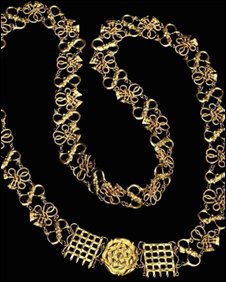 The only known surviving chain of office from the time of Henry VIII is being put up for auction. The king gave the gold Coleridge Collar to one of his closest advisers, Sir Edward Montagu, around 1546. The chains showed allegiance to the monarch and the intricacy of the design and quality of the metal signified the status of the wearer. It is expected to fetch £300,000 when it goes under the hammer at Christie's in London on 6 November. It will be the first time that the Coleridge Collar, thought to be of the most important surviving relics of the Tudor age, has come up for auction. Sir Edward is thought to have received the collar on his appointment to the role of Lord Chief Justice of the Common Pleas - one of the highest judicial officials in England. This type of livery collar, as it was known, became popular when they were used by Henry IV as an official symbol of allegiance to the monarch. It was known as the "collar of the Esses", referring to the S characters used in the design alluding to the Latin religious creed Spiritus Sanctus - or holy spirit. The Tudors later added their own designs of roses and portcullises. Henry VIII is thought to have awarded only about 20 of the chains to loyal subjects for "special deeds" and none were believed to have survived in their entirety. The only known surviving chain of office from the time of Henry VIII is being put up for auction. The king gave the gold Coleridge Collar to one of his closest advisers, Sir Edward Montagu, around 1546. The chains showed allegiance to the monarch and the intricacy of the design and quality of the metal signified the status of the wearer. It is expected to fetch £300,000 when it goes under the hammer at Christie's in London on 6 November. It will be the first time that the Coleridge Collar, thought to be of the most important surviving relics of the Tudor age, has come up for auction. Sir Edward is thought to have received the collar on his appointment to the role of Lord Chief Justice of the Common Pleas - one of the highest judicial officials in England. This type of livery collar, as it was known, became popular when they were used by Henry IV as an official symbol of allegiance to the monarch. It was known as the "collar of the Esses", referring to the S characters used in the design alluding to the Latin religious creed Spiritus Sanctus - or holy spirit. The Tudors later added their own designs of roses and portcullises. Henry VIII is thought to have awarded only about 20 of the chains to loyal subjects for "special deeds" and none were believed to have survived in their entirety. But when the role of Lord Chief Justice of the Common Pleas was merged with another title in 1880 to create the Lord Chief Justice of England - the chain of office became superfluous. It then became the personal property of Lord Coleridge and passed through his family, changing ownership only once since the 19th Century. It was discovered in the Devon family home of poet Samuel Taylor Coleridge earlier this year. Experts say the collar is similar to the one worn by Sir Thomas More in the famous portrait by Hans Holbein the Younger. Andreas Pampoulides, Christie's London director and co-head of sale said: "The Coleridge Collar is an extraordinary and fascinating piece of history, both as a work of art, and also as a rare Tudor relic. "An extremely rare example of early English goldsmith-work, the collar also represents the only known, complete, surviving collar of office from the time of Henry VIII, one of the most renowned of European monarchs." The collar is part of Christie's Important European Furniture, Sculpture and Tapestries sale. [Source : <a class="external" href="http://news.bbc.co.uk/1/hi/uk/7653348.stm" rel="nofollow" target="_blank" title="BBC news">BBC news</a> October 5, 2008] |
| <a class="external" href="http://www.youtube.com/watch?v=bpkk_zNTU2c" rel="nofollow" target="_blank" title="A Video featuring Henry's prayer roll">A Video featuring Henry's prayer roll</a> |
| <embed allowfullscreen="true" flashvars="config_settings_showUpdatedInFooter=true&config_settings_showPopoutButton=false&playlist=http%3A%2F%2Fnews%2Ebbc%2Eco%2Euk%2Fmedia%2Femp%2F8110000%2F8116000%2F8116029%2Exml&config=http%3A%2F%2Fnews%2Ebbc%2Eco%2Euk%2Fplayer%2Femp%2Fconfig%2Fdefault%2Exml%3F2%2E18%2E13034%5F13155%5F20091009165324&config_settings_language=default&config_settings_showFooter=true&config_plugin_fmtjLiveStats_pageType=eav6&config_settings_showPopoutButton=false&config_settings_showPopoutCta=false&config_settings_addReferrerToPlaylistRequest=true" height="400" src="http://widget.wetpaintserv.us/wiki/thetudorswiki/widget/unknown/552e41d0d3a3ee1392f068f33ffb2f266a6e307e" type="application/x-shockwave-flash" width="512" wmode="transparent"/> Replica of letter on Henry VIII divorce unveiled VATICAN CITY — Officials unveiled a replica of a 1530 parchment sent by members of England’s House of Lords to Pope Clement VII to support the divorce of King Henry VIII. The 3-foot-by-6.5 foot (1-meter-by-2-meter) parchment with more than 80 original red wax seals of the signatories is considered a crucial document in the king’s battle to divorce his first wife, Catherine of Aragon. At the time, Henry VIII was obsessed with producing a male heir to the throne. The Vatican’s refusal to annul the marriage led the king to reject the authority of the pope and install himself as head of the Church of England. He then married Anne Boleyn. and Tudor family expert, said in an interview with Associated Press Television News. “This is the moment at which England ceases to be a normal European Catholic country and goes off on this strange path that leads it to the Atlantic, to the new world, to Protestantism, to Euro-skepticism.” |
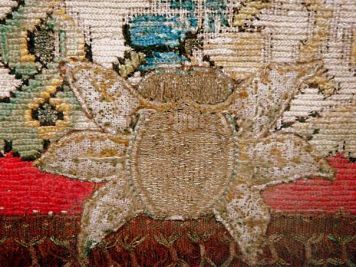 Queen Katherine of Aragon's Queen Katherine of Aragon's emblem of the pomegranate. From an altar cloth made by Katherine that is currently housed in St Peter’s Church in Winchcombe, Gloucestershire. | Royal Desk with King Henry & Queen Katherine of Aragon's arms Link: <a class="external" href="http://www.vam.ac.uk/collections/furniture/videos/royal_desk/broadband.html" rel="nofollow" target="_blank" title="Video of the royal desk at the V&A">Video of the royal desk at the V&A</a> |
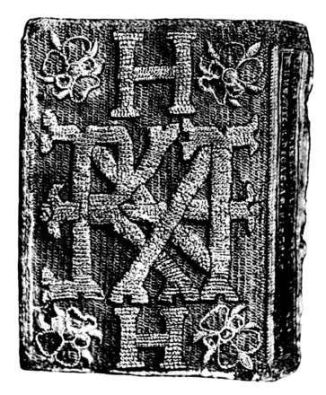 Prayers or Meditations by Queen Catherine Parr. Translated into Latin, French, and Italian by the [Lady] Princess Elizabeth Tudor. 1545. ENGLISH EMBROIDERED BOOKBINDINGS CHAPTER II - Book Bound in Canvas BY CYRIL DAVENPORT, F.S.A | Another manuscript beautifully written by the Princess Elizabeth Tudor is now at the British Museum. It is on vellum, and contains prayers or meditations, composed originally by Queen Catherine Parr in English, and translated by the Lady Elizabeth into Latin, French, and Italian. The title as given in the book reads, 'Precationes ... ex piis scriptoribus per nobiliss. et pientiss. D. Catharinam Anglie, Francie, Hibernieq. reginam collecte, et per D. Elizabetam ex anglico converse.' It is, moreover, dedicated to Henry VIII, the wording being, 'Illustrissimo Henrico octavo, Anglie, Francie, Hibernieq. regi,' etc., and dated Hertford, 20th December 1545. It is bound in canvas, and measures 5¾ by 4 inches, the groundwork being broadly worked in tapestry-stitch, or some stitch analogous to it, in red silk, resembling in method the work on the ground of The Miroir of the Synneful Soul described below. On this, in the centre of each side, is a large monogram worked in blue silk, interwoven with silver thread, containing the letters K, probably standing for Katherine, A, F, H, and R, possibly meaning 'Anglie, Francie, Hibernieque, Reginæ,' but like most monograms this one can doubtless be otherwise interpreted. Above and below the monogram are smaller H's, worked in red silk, interwoven with gold thread. In each corner is a heartsease of yellow and purple silk, interwoven with gold thread, and having small green leaves between each of the petals. The work which was once on the back is now so worn that it cannot be traced sufficiently to tell what it originally was. |
| Psalter belonging to Mary I. The beautiful English manuscript of the fourteenth century known as 'Queen Mary's Psalter' was presented to her in 1553. It is bound in crimson velvet, measuring 11 by 6¾ inches, and appliqué on each side is a large conventional pomegranate-flower worked on fine linen in coloured silks and gold thread. This flower is much worn, but enough is left to show that it was originally finely worked. Queen Mary used the pomegranate as a badge in memory of her mother, Katharine of Aragon. The volume has been re-backed in plain crimson velvet, and still retains the original gilt corners with bosses, and two clasps, on the plates of which are engraved the Tudor emblems,—portcullis, dragon, lion, and fleur-de-lys. -- ENGLISH EMBROIDERED BOOKBINDINGS Chapter III - Books Bound in Velvet BY CYRIL DAVENPORT, F. S. A | 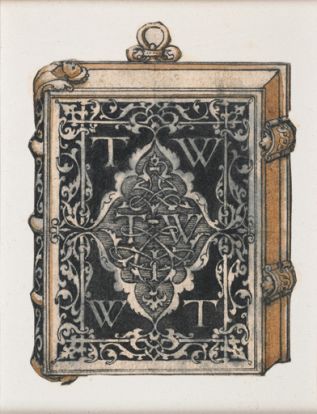 Hans Holbein the Younger (1497/8–1543) Designs for Metalwork Covers and Caskets (about 1537) The two book covers feature clasps to close the book and a ring by which such small books were usually attached to a woman’s girdle (see the examples in the case nearby). Both books bear the initials ‘T’, ‘W’ and ‘I’, which probably stand for those of Sir Thomas Wyatt the Younger and his wife Jane Haute, who were married in 1537. Source: Tate Gallery, London, Holbein exhibit online. |
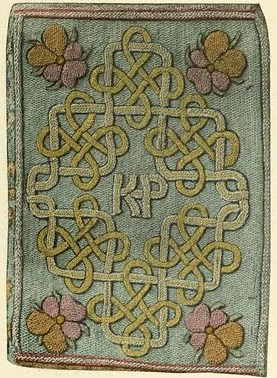 Elizabeth's embroidery of her translation of the French poem The Mirror of the Sinfoul Soul, 1544 | Left: This Miroir or Glasse of the Synneful Soul Princess Elizabeth Tudor in her eleventh year, copied out in her own handwriting the Miroir or Glasse of the Synneful Soul. She says it is translated 'out of frenche ryme into english prose, joyning the sentences together as well as the capacitie of my symple witte and small lerning coulde extende themselves.' It is also most prettily dedicated: 'From Assherige, the last daye of the yeare of our Lord God 1544 ... To our most noble and vertuous Quene Katherin, Elizabeth her humble daughter wisheth perpetuall felicitie and everlasting joye.' The design is the same upon both sides. The ground is all worked over in a large kind of tapestry-stitch in thick pale blue silk, very evenly and well done, so well that it has been considered more than once to be a piece of woven material. On this is a cleverly designed interlacing scroll-work of gold and silver braid, in the centre of which are the joined initials K. P. [for Katherine Parr] The back is very much worn, but it probably had small flowers embroidered upon it. ENGLISH EMBROIDERED BOOKBINDING Chapter II - Books Bound in Canvas BY CYRIL DAVENPORT, F.S.A |
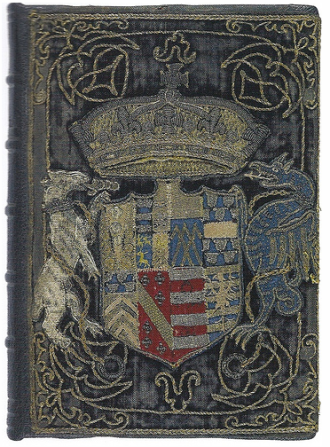 Il Petrarcha. Venetia, 1544; Catherine Parr. | Il Petrarcha. Venetia, 1544. Another fine example of the decorative use of Heraldry occurs on a copy of Petrarch printed at Venice in 1544, and probably bound about 1548, after the death of Henry VIII. It belonged to Queen Catherine Parr, and bears her arms with several quarterings—worked appliqué on rich blue purple velvet, and measures 7 by 6 inches. The first coat is the 'coat of augmentation' granted to the Queen by Henry VIII —'Argent, on a pile gules, between six roses of the same, three others of the field'—and the next coat is that of 'Parr/Green.' [Catherine's parents impaled arms] |
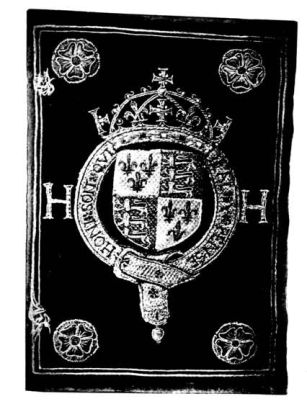 The earliest extant English binding in embroidered velvet covers this manuscript, which belonged to Henry VIII, and is dedicated to him. The manuscript is on vellum, and is beautifully illuminated. It is bound in rich purple velvet, and each side, measuring 9 by 6 inches, is ornamented with the same design. In the centre is a large royal coat-of-arms, surrounded by the garter, and ensigned with a royal crown. On the coat are the arms of France and England quarterly; the bearings, respectively three fleur-de-lys and three lions, are solidly worked in gold cord, and the whole is appliqué on to the velvet with strong stitches. On the blue garter the legend 'Honi soit qui mal y pense' is outlined in gold cord, between each word being a small red rose, the buckle, end, and edge of the garter being marked also in gold cord, and the whole appliqué like the coat. There is a letter H on each side of the coat-of-arms, and these letters were originally doubtless worked with seed pearls, but the outlines of them alone are now left. In each corner is a red Lancastrian rose. This is certainly a very handsome piece of work, and is wonderfully preserved. It is the earliest example of a really fine embroidered book on velvet in existence, and it has perhaps been more noticed and illustrated than any other book of its kind. -- ENGLISH EMBROIDERED BOOKBINDINGS Chapter III - Books Bound in Velvet BY CYRIL DAVENPORT, F. S. A | 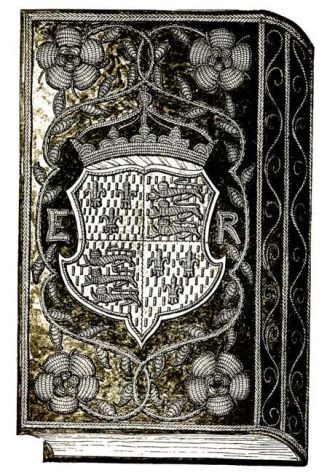 Udall, Sermons. London, 1596. (From a drawing). A few specimens of embroidered books were exhibited at the Burlington Fine Arts Club in 721891. Among them was a charming velvet binding that belonged to Queen Elizabeth, lent by S. Sandars, Esq., and now in the University Library, Cambridge. It is a copy of Udall's Sermons, printed in London in 1596, and is covered in crimson velvet, measuring about 6 by 4 inches. The design is the same on each side, the royal coat-of-arms appliqué, with the initials E. R., and a double rose in each corner with stalks and leaves. The coat-of-arms is made up with pieces of blue and red satin, the bearings heavily worked with gold thread, and the ground also thickly studded with small straight pieces of guimp, doubtless put there to insure the greater flatness of the satin. The crown with which the coat-of-arms is ensigned is all worked in guimp, and is without the usual cap. The ornaments on the rim are only trefoils, and there are five arches. ENGLISH EMBROIDERED BOOKBINDINGS Chapter III - Books Bound in Velvet BY CYRIL DAVENPORT, F.S.A |
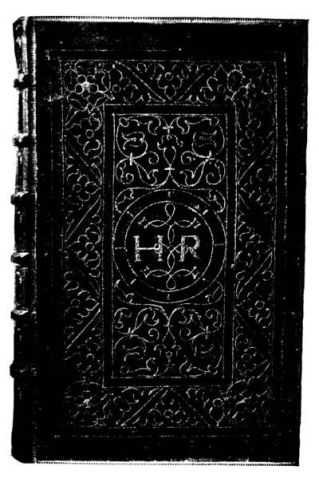 Biblia. Tiguri, 1543. This Bible belonged to Henry VIII. It is bound in velvet, originally some shade of red or crimson, but now much faded. It measures 15 55by 9¼ inches. It is ornamented with arabesques and initials all outlined with fine gold cord. In the centre are the initials H. R., bound together by an interlacing knot, within a circle. Arabesques above and below the circle make up an inner panel, itself enclosed by a broad border of arabesques, with a double, or Tudor, rose in each corner. The edges of the leaves of the book are elaborately painted with heraldic designs. It has been re-backed with leather, but still retains the original boards. -- ENGLISH EMBROIDERED BOOKBINDINGS Chapter III - Books Bound in Velvet BY CYRIL DAVENPORT, F. S. A |
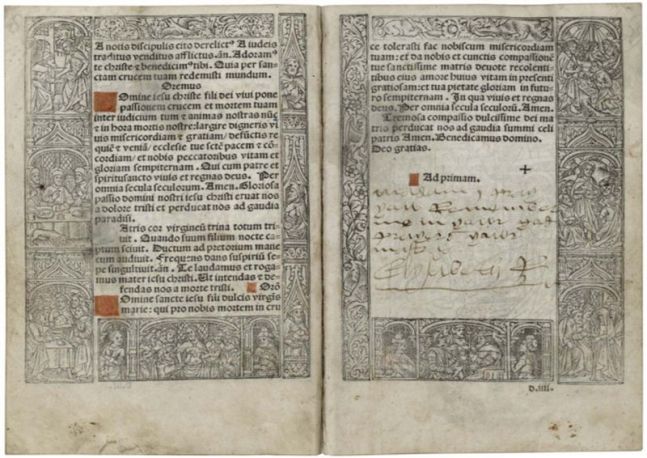 Prayer Book. inscribed by Elizabeth of York, Henry VIII’s mother Incipiunt hore beate Marie virginis secudum vsum Sarum, a book of prayers and devotions (1498), inscribed by Elizabeth of York, queen consort of Henry VII and the mother of Henry VIII, "Madam j pray yow Remember me in yowr good prayers yawr mastras Elyzabeth R" (cat. 8). Photo credit: By permission of the Folger Shakespeare Library’s. |
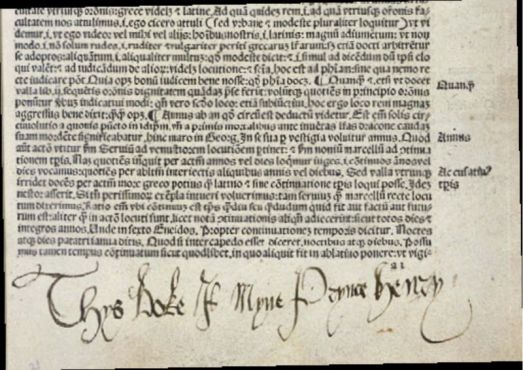 Henry VIII schoolbook copy of Cicero's Commentum familiare in Ciceronis officia (1502), inscribed "Thys Boke is Myne Prynce Henry" (cat. 13). Photo credit: by permission of the Folger Shakespeare Library |
Prayer book of Catherine Parr given by her to Miss Tuke, daughter of Sir Bryan Tuke one of the King's Secretaries. Inherited by Margaret Hastings and given to Thos Lawrence in 1669 by whom it is inscribed. 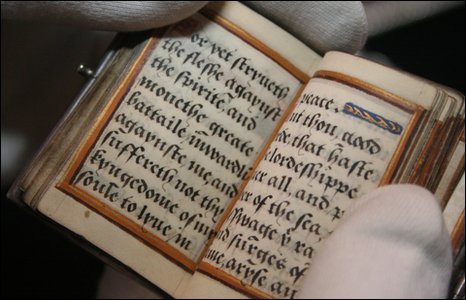 |
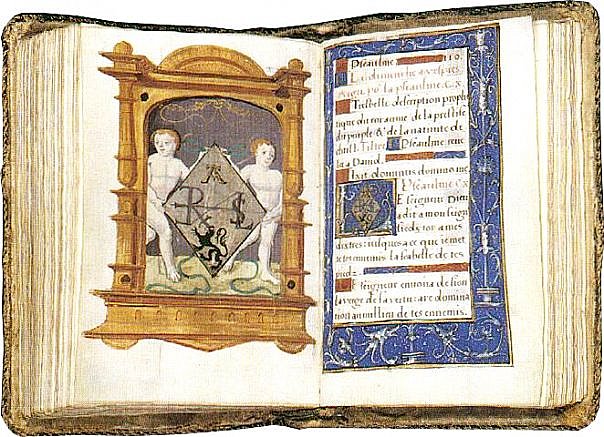 Anne Boleyn’s Psalter (prayer book). The language of the text is French and on the shield depicted on the left page is her father’s symbol; the Rochford badge of the black lion. The book has been dated to c.1529-1532. |
 The 'Boleyn Cup' which belonged to Anne Boleyn and made in 1535 can be seen at the St. John the Baptist Parish Church, Cirencester, Gloucestershire and supports Anne Boleyn's crest of a crowned falcon on a tree stump with red and white flowers. It was made out of silver and gilt. It was apparently passed on to her daughter, Elizabeth, who then passed it on to her physician as a gift, who eventually gave it to the Church where it still lives today. The design for the table fountain presented by Anne Boleyn to Henry as her New Year's gift in 1534 incorporates her falcon badge |
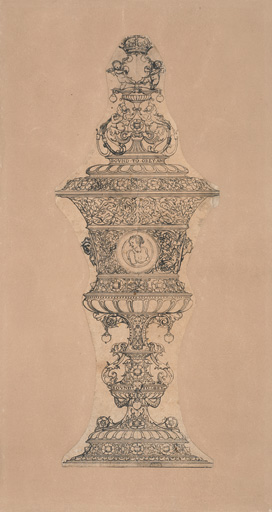 Hans Holbein the Younger (1497/8–1543) and Workshop? Design for a Cup for Jane Seymour (1536–7) This is the preliminary design for a magnificent gold cup evidently intended to be given by Henry VIII to Queen Jane Seymour; they married on 30 May 1536. The Queen’s motto, ‘bound to obey and serve’, is repeated on the lid and on the foot, while the King and Queen’s initials are intertwined with love knots. Holbein began by drawing the left hand side of the design, and also made a number of alterations. The right hand side is more hastily executed, and might be the work of an assistant, who had difficulty with the proper spacing of the initials H and I. |
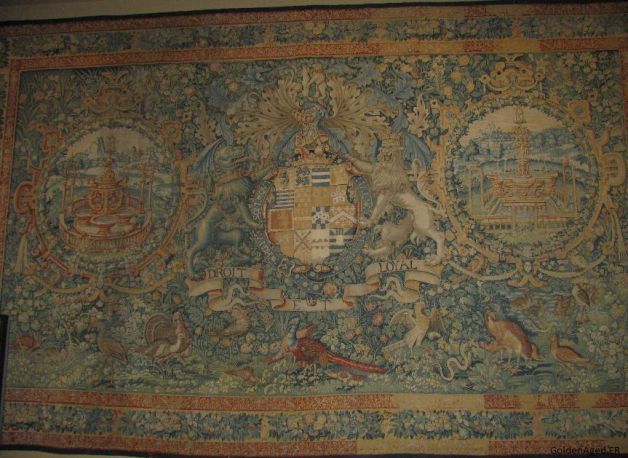 Tapestry made c. 1585. Made for the Leicester House in London. Robert Dudley, 1st Earl of Leicester (about 1532-1588) [son of the Duke of Northumberland and brother of Lord Guildford Dudley, husband of Lady Jane Grey de facto Queen of England], who was at one time Elizabeth I's favourite courtier, commissioned this tapestry. His coat of arms in the middle proclaims his power and noble birth. The tapestry includes fashionable decoration of foliage, birds and other creatures with Renaissance fountains, based on contemporary engravings. The sophisticated design makes it difficult to confirm that this tapestry was made in the Sheldon workshop in Barcheston, Warwickshire, although this was once thought to be the case. [featured in the Victoria and Albert Museum, London, picture courtesy of GoldenAged.ER] |
Small pics
| at Hever Castle | Ornate Clock: a gift from Henry to Anne | |
| Anne Boleyn's Lute | A miniature whistle pendant in the form of a pistol, chased with scrolling foliage and containing cosmetic tools within the barrel. According to tradition, this little gift was Henry VIII’s first gift to Anne Boleyn. Such little trinkets were often sewn onto the king’s masque costumes.They could be given away as gifts, easily lost or even stolen. For example, in September 1510 a goldsmith was paid £266 to make new trinkets including small hearts and roses in gold because so many former charms had been stolen or ‘given away at his [Henry’s] pleasure’ | 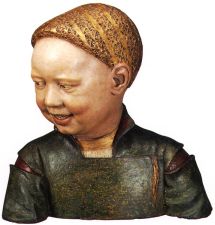 A bust said to be that of King Henry VIII as a child. |
| The Boleyn falcon – from a lace canopy said to have been made by Anne Boleyn for the christening of Elizabeth I. The lace canopy is housed at Sudeley Castle. How the canopy ended up there is debatable, although it may have been brought there by Catherine Parr, whose husband, Thomas Seymour, Baron Seymour of Sudeley, owned the castle. Katherine went to Sudeley Castle for the birth of her child, Lady Mary Seymour in the summer of 1548 and may have brought the canopy for the baby’s christening. | Elizabeth I's christening robe, now at Sudeley Castle | |
 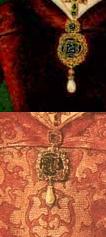 La Pelegrina, a teardrop pearl given to Mary I by her husband Phillip II. Mary had the pearl attached to the bottom of her brooches. After the death of Mary I, the pearl was brought back to Spain where it became part of the Crown Jewels. The pearl became a favorite of the queen consorts and even the Kings of Spain. It was brought to England by Charles Louis Bonaparte during his exile. It is believed that he sold the pearl to the 2nd Marquess of Abercorn. The pearl was bought by Richard Burton for Elizabeth Taylor in 1969 at Sotheby's Auction House. When Elizabeth died in 2011 the pearl, which she had attached to a diamond necklace, was on display; it eventually sold at an auction in 2012 to an anonymous buyer. For more info see: Royal Jewelry, page 2 | The Darnley Jewel c.1571-8, A golden heart set with jewels, and ornamented with emblematic figures enamelled, at Scottish mottoes; made by the order of the Lady Margaret Douglas, daughter of Princess Margaret Tudor, Queen of Scots, and mother of Henry Lord Darnley, in memory of her husband Matthew Stuart, earl of Lenox and regent of Scotland who was murdered by the papists. On the pendant are emblems and symbols that represent Margaret's hope that her grandson James I would succeed Elizabeth I for the throne of England. The Royal Collection, Windsor Castle For more info see: Royal Jewelry, page 2 | 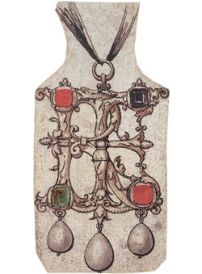 Hans Holbein the Younger (1497/8–1543) Designs for Pendants (about 1540–3) The British Museum, London Pen and black ink with black wash background. Jewellery designed by Holbein of Henry's and Jane's (Ioanna) initials intwined with love knots. |
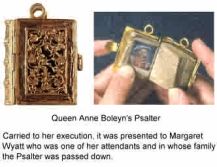 Anne Boleyn's prayer book that it is said she carried to her execution. (this is disputed as a victorian legend) | 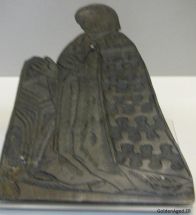 'Palimpsest' Flemish brass c.1410; re-engraved in London c. 1530. Plate of King Henry's mistress and mother of Henry Fitzroy; Elizabeth "Bessie" Blount. Description from The British Museum: A palimpsest is a commemorative plaque that has been re-used. *Ironically on the back is a Virgin in medieval architecture. Picture courtesy of GoldenAged.ER |
Larger pics
| A description of Anne Boleyn’s coronation was set down in pamphlet form shortly after the festivities by the London printer Wynkin de Worde. Entitled The Noble Tryumphaunt Coronacyon of Quene Anne - Wyfe unto the Noble Kynge Henry the VIII, it consisted of 11 typeset pages with a rather crude woodcut of a courtly scene on the front cover. Left: The Noble Tryumphaunt Coronacyon of Quene Anne - Wyfe unto the Noble Kynge Henry the VIII (printed by Wynkyn de Worde in 1533) | |
| Marital capitulations of Katherine of Aragon and Arthur, Prince of Wales. | Elizabeth I miniature portrait on vellum playing card, 1572 by Nicholas Hilliard |
| A lock of hair believed to belong to Catherine Parr The inscription reads "Hair of Queen Catherine Parr, last consort of Henry, the night she dyed September 5th 1548 was in the Chapel of Sudeley Castle, near Winchcombe." | 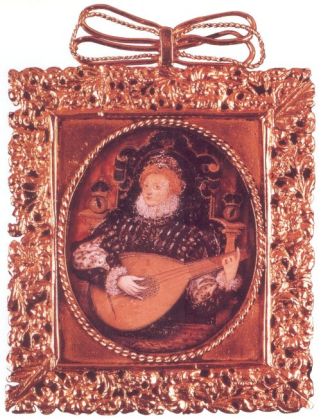 Miniature of Elizabeth playing the lute, one of her favorite instruments. Date unknown by Nicholas Hilliard |
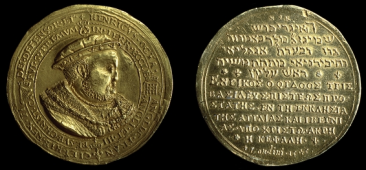 Henry asserted his new authority as "Supreme Head of the Church of England" in official imagery, as we see on this medal by an anonymous artist. The king is shown wearing a jewelled cap, ermine robe and jewelled collar, with a legend in Latin around the edge divided by Royal emblems. It translates as 'Henry VIII, King of England, France and Ireland, defender of the faith, and under Christ, the supreme head on earth of the Church of England and Ireland'. The same message is presented on the reverse in Hebrew and Greek, the other two languages of the Bible, to affirm the legitimacy of Henry's appointment. This is one of only two known surviving examples in gold. E. Hawkins, Medallic illustrations of the (London, Trustees of the British Museum, 1885) | 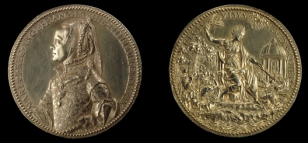 Brussels or London, about AD 1554-55 by Jacopo da Trezzo (about 1514-89) was a goldsmith who worked for King Philip II of Spain. This medal depicts Queen Mary I. Having her portrait made by a Milanese medallist was part of the process of presenting herself to the world as a Habsburg bride. At about the same time, the Habsburg court portraitist, Antonis Mor (about 1516-1576), was sent to paint Mary's portrait. The images by the painter and the medallist are closely related. The reverse of the medal is intended to suggest the peaceful state of England under Mary's rule, with a figure of Peace burning arms and armour, and banishing storm clouds. Beneath her are symbols of stability, unity, and justice. Given Mary's terrible persecution of Protestants during her reign, for which she earned the by name 'Bloody Mary', it was hardly an accurate image. The medal may have been commissioned by Philip as a gift to Mary. P. Attwood, The currency of fame: portra-7, exh. cat. (New York, 1994) E. Hawkins, Medallic illustrations of the (London, Trustees of the British Museum, 1885) |
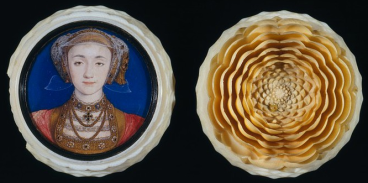 Miniature of Anne of Cleves by Holbein c. 1539 In 1539 it became politically necessary for Henry to form an alliance with Protestant Germany and it was suggested that Henry marry one of the daughters of the Duke of Cleves. Henry needed to judge whether to proceed with the marriage treaty and Holbein was dispatched to paint Anne and her sister Amelia. When Anne arrived in England, Henry thought her 'nothing so fair as had been reported', but the marriage still took place, in 1540. A few months later Henry decided the alliance was no longer necessary and the marriage was declared null. He designated Anne 'King's sister' and she settled down to life in England. The ivory box is probably contemporary with the miniature. It was turned on a lathe. Such skilled turning of ivory was unknown in England at this date but was common in Germany. It is possible that Holbein had the box specially made while he was in Germany, painting Anne of Cleves. © Victoria and Albert Museum, London | 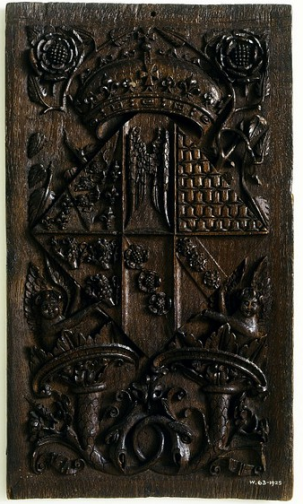 Wood panel made c.1536 depicting the arms of Jane Seymour as Queen. She married Henry VIII in 1536 and their alliance is represented by the combination of Seymour family arms with those of Henry VIII. The top left hand 'quarter' of the lozenge comprises three lion guards, Henry's heraldic 'supporters', and a repeated fleur-de-lis motif. The fleur-de-lis was one of several badges used by the King. The crown and Tudor roses above the lozenge also represent Jane's royal status. © Victoria and Albert Museum, London |
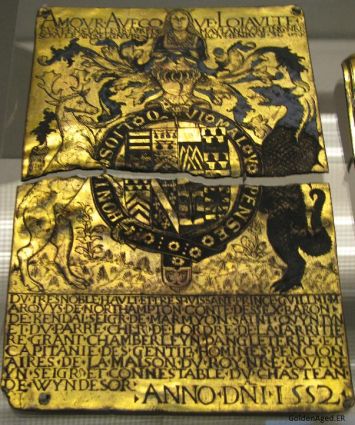 Stall-plate; copper-gilt; enamelled; Order of the Garter; dated; arms and quarterings of Sir William Parr; helm with woman crest and scrolls; supporters; pierced corners; inscriptions top and bottom; originally in St George's Chapel, Windsor Castle; now in two pieces. The plate lies next to Edward Seymour's in The British Museum, London. Gilt copper, enamel; England, 1522 Made for Sir William Parr (1513-71), brother of Queen Catherine Parr, Henry VIII’s sixth wife. Sir William became a Knight of the Garter in 1552. The following year he was indicted for treason, and his stall-plate was deliberately broken. Sir William Parr was stripped of his titles by Queen Mary I during her reign; Parr regained his titles under the reign of Elizabeth I and was further advanced during the reign of Edward VI becoming the second most powerful man in England. The queen paid for his funeral and burial in St. Mary's Church, Warwick, coincidentally where Robert Dudley is also buried. Picture courtesy of GoldenAged.ER | 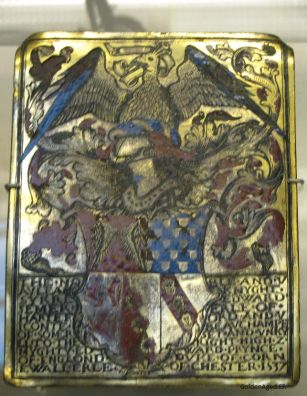 Garter stall-plate. Guilt copper enamel, London 1537. Made for Sir Edward Seymour (d.1552), later Duke of Somerset; brother of Queen Jane Seymour and uncle to Edward VI. Seymour advanced himself as Duke of Somerset. After his arrest for treason his stall-plate was taken down but ironically not broken in two like other disgraced Knights of the Garter usually were [see left, William Parr]. This plate lies next to William Parr's plate, which is bigger, in The British Museum in London. Description in The British Museum, London: When King Henry died in 1547, Seymour took the role of 'Lord Protector' for his nephew, Edward VI, who was too still too young to ascend the throne. Picture courtesy of GoldenAged.ER |
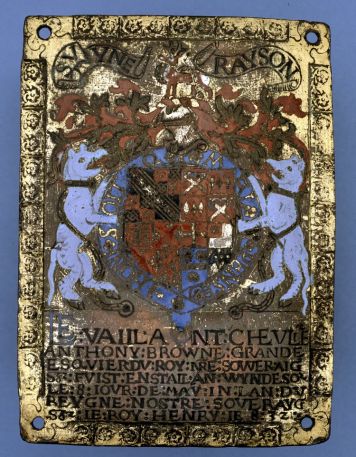 Stall-plate of the Order of the Garter; copper-gilt and enamelled with arms of Sir Anthony Browne, executor of King Henry VIII's will; bear supporters; leopard or stag. He was the son of Sir Anthony Browne, Standard Bearer of England and Governor of Queenborough Castle, by his wife Lady Lucy Neville, daughter of John Neville, 1st Marquess of Montagu and widow of Sir Thomas Fitzwilliam. Anthony junior was thereby half-brother of William Fitzwilliam, 1st Earl of Southampton. He became so trusted by Henry that in the King's latter years, Browne held a dry stamp of the King's signature, to use for minor letters. By 1547, he was Keeper of Oatlands Palace. Two members of his family were said to have been mistresses of Henry VIII. One, 'Mistress Browne', we do not know the first name of, but it was allegedly his sister. One piece of information, however, points to it being his daughter, Elizabeth Browne, countess of Worcester. The ex-mistress was alleged to have been a prime mover in the downfall of Anne Boleyn. Elizabeth Browne was a lady-in-waiting to Queen Anne Boleyn and the chief witness against her. Garter stall-plate on display at The British Museum, London. | 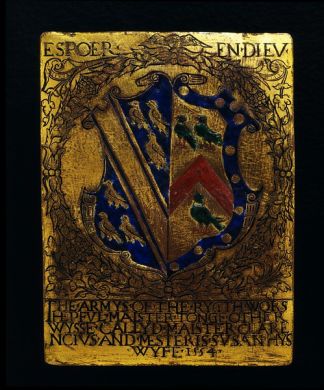 Sir Thomas Tonge, plate c. 1554 This plaque may have been commissioned as a memorial. Similar ones can be seen in St. George's Chapel, Windsor, where they denote the stalls reserved for the Knights of the Order of the Garter. This plaque shows the arms of Sir Thomas Tonge and his wife Susan. Sir Thomas held important posts at the College of Arms during the reign of Henry VIII. Similar enamelled plaques were used to denote seats reserved for the Knights of the Order of the Garter at St. George's Chapel, Windsor Castle. [27/03/2003] Sir Thomas Tonge (d.1536) was Clarenceux King of Arms, an important post in the College of Arms. His wife Susan (d.1565) survived her husband by 30 years and became First Lady of the Privy Chamber to Mary I. As a Roman Catholic, she would not have been able to commission such a plaque until Mary Tudor became Queen in 1553, 18 years after the death of Thomas. Protestants did not approve of memorials of this sort. © Victoria and Albert Museum, London |
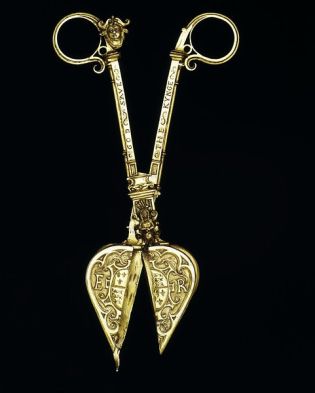 The snuffers [made c. 1547-1553] bear the arms of Edward VI along with the inscriptions 'GOD SAVE THE KYNGE' and 'EDWARDE WYTHE ALL HIS NOBLE COUNCEL'. Prince Edward Tudor, the only surviving son of Henry VIII became king from 1547 to 1553 and was succeeded by his half-sisters Mary Tudor and Elizabeth Tudor. The snuffers were passed down through the family of his uncle, Edward Seymour, Duke of Somerset and Lord Protector, who was the brother of Jane Seymour, the King's mother. These snuffers are an extremely rare survival from the Tudor court and show the care lavished by the court goldsmiths on small domestic items.The heart-shape of the wick box and the chased central panel were standard decorative forms in northern Europe. The lack of a hallmark may suggest that this was a special order for the court and not sold in a shop. © Victoria and Albert Museum, London |
LETTERS & HANDWRITING:
| Actual letter from Henry to Anne, written in French before their marriage and now housed in The Vatican | 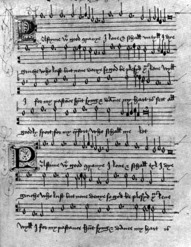 A piece of music written by Henry's hand |
Letter from Katherine of Aragon to the Pope. In the letter, written in spanish, Katherine pleads to the Pope to save her marriage. She signed it "Katherina the Queene". The letter recently sold for 80,000 pounds. 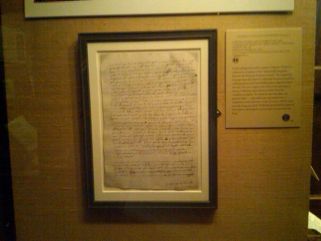 Actual letter on display at the Shakespeare Library in Washington D.C.; exhibition "Vivat Rex." © GoldenAged.ER | 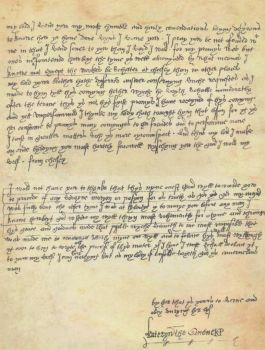 Letter from the Queen Dowager Catherine Parr to Lord Thomas Seymour THE QUEEN TO THE LORD ADMIRAL My Lord I send you my most humble and hearty commendations being desirous know how ye have done since I saw you I pray you be not offended with me in l send sooner to you than I said I would for my promise was but once in a fortnight Howbeit the time is well abbreviated by what means I know not except the weeks shorter at Chelsea than in other places My Lord your brother hath deferred concerning such requests as I made to him till his coming hither which he saith shall immediately after the term This is not his first promise I have received of his coming and yet unperformed I think my Lady hath taught him that lesson for it is her to promise many comings to her f1iends and to perform none I trust in greater she is more circumspect And thus my Lord I make an end bidding you most farewell wishing you the good l would myself From Chelsea I would not have you to think that this mine honest good will towards you to proceed of any sudden motion or passion for as truly as God is God my mind was bent the other time I was at liberty to marry you before any man one know Howbeit withstood my will therein most vehemently for a time and through His grace and goodness made that possible which seemeth to me most impossible that was made me to renounce utterly mine own will and to follow His will most willingly It were too long to write all the process of this matter if I live I shall declare it to you myself I can say nothing but as my Lady of Suffolk saith God is marvellous man By her that is yours to serve and obey during her life. Katherine the Queen KP |
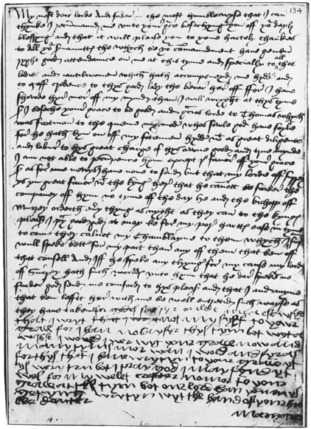 A letter written by Princess Margaret Tudor to her father, Henry VII. The letter is made up mostly of Margaret asking her father to thank her servants and people of the Tudor court who tended to her whilst she was in England and those who accompanied her to Scotland. | A document bearing the signature ‘Anne the Quenen’, written by Anne of Cleves during her short time as Queen of England |
Love letter that Katherine Howard wrote to Thomas Culpeper while married to the king. She was barely literate and spelling wasn't fixed. It begins, "Master Coulpeper, I hertely recomend me unto youe praying you to sende me worde how that you doo.... ytt makes my harte to dye to thynke what fortune I have that I cannot be always yn your company.... I wode you was wythe me now that yoo maitte se what pane I take yn wryte[n]g to you. Yours as long as lyffe endures Katheryn" | Edward VI's 'Devise for the Sucession' Edward removed his two sisters, Mary and Elizabeth, from the succession and instead made his cousin, Lady Jane Grey his successor. Edward made a mistake on the fourth line, and crossed out 'heires masles', as he realised that Jane would not have any sons before he died and so changed it to 'L Jane and her heires masles'. |
Effigies
| Left: Painted plaster bust of the funeral effigy of Henry VII, father of Henry VIII, who died in 1509, from the collection of effigies in the Undercroft Museum in Westminster Abbey. The effigy is thought to be modeled on Henry's actual death mask because of the clotting of the right eyebrow hair caused by the grease that would have eased the removal of the plaster death mask. The effigy which once had a whole body was damaged during the bombings of London in WWII. This image resembles the terra cotta bust (right) of Henry VII as well as the tomb scuplture done by Pietro Torrigiano. Funeral effigy of Elizabeth of York, wife to Henry VII of England and mother to Henry VIII. She was therefore Queen Mary I’s paternal grandmother. The effigy was carried in her funeral procession and is carved in wood. As it is not the death mask it is questionable how much it fully reflections Elizabeth’s real appearance. Elizabeth died on 11th February 1503 shortly after the birth of a daughter Katherine who died before her mother. Her death was greatly mourned as she appears to have been liked and admired by the majority. The narrative of her funeral describes her as ‘one of the most gracious and best beloved Princesses in the world’. |
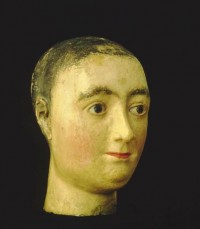 The wax funeral effigy of Mary I. It is currently displayed in the museum of Westminster Abbey. The wax effigy of Elizabeth I at Westminster Abbey. (below, left) |
A replica of a 16th century wine fountain recently installed at Hampton Court Palace.
